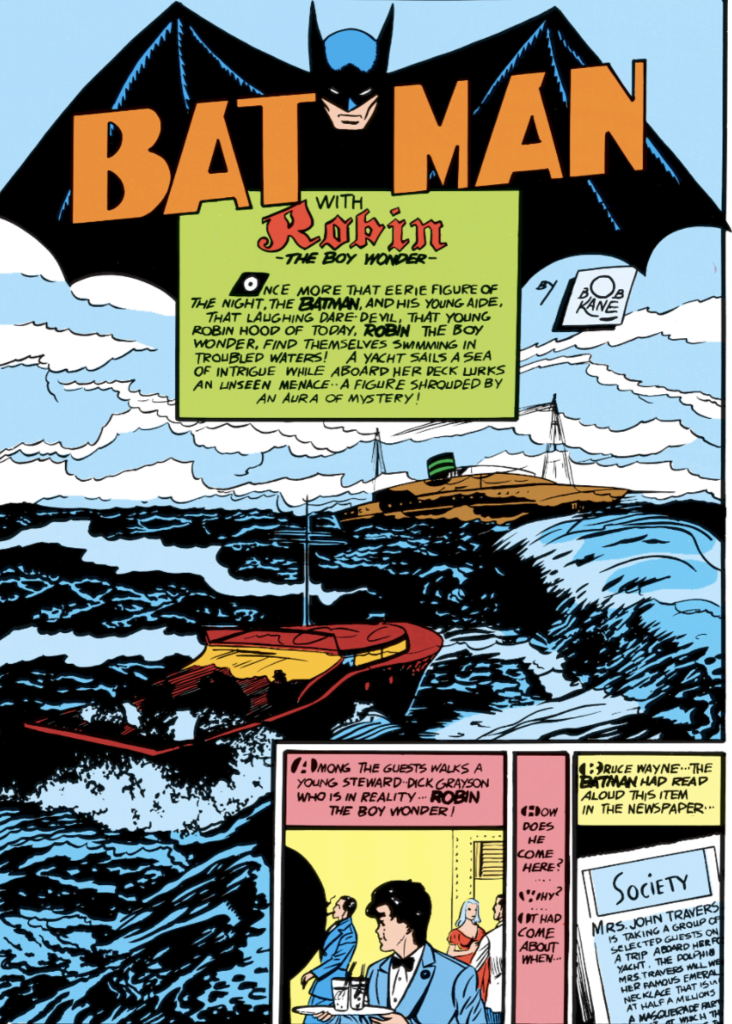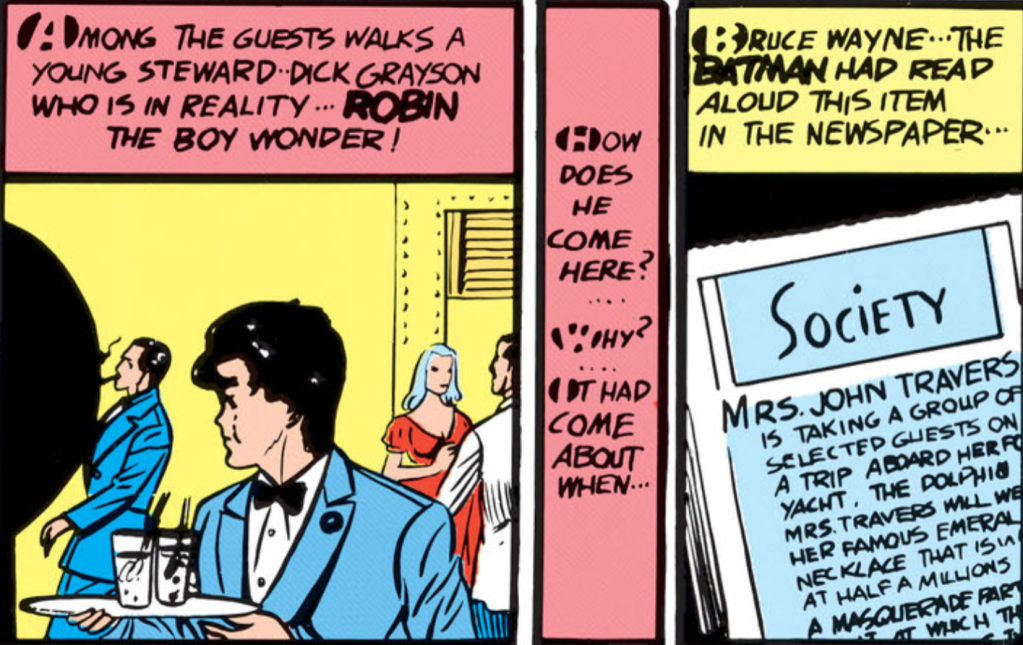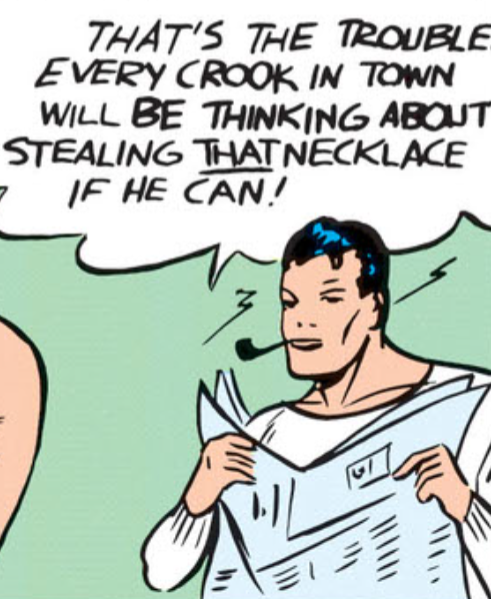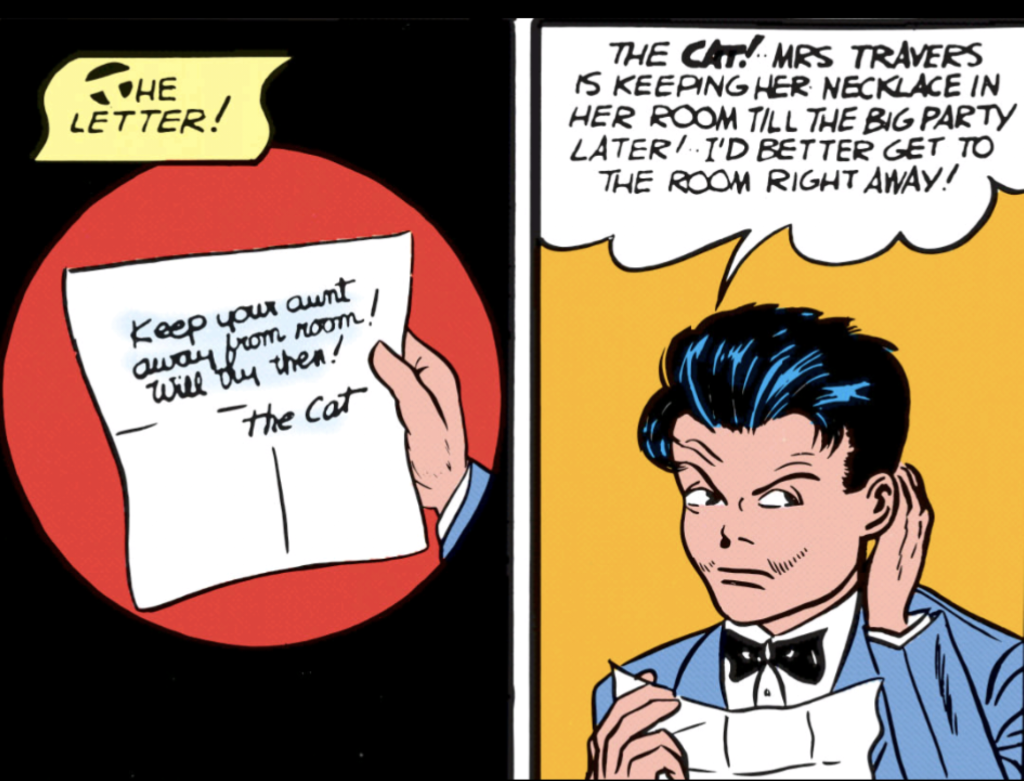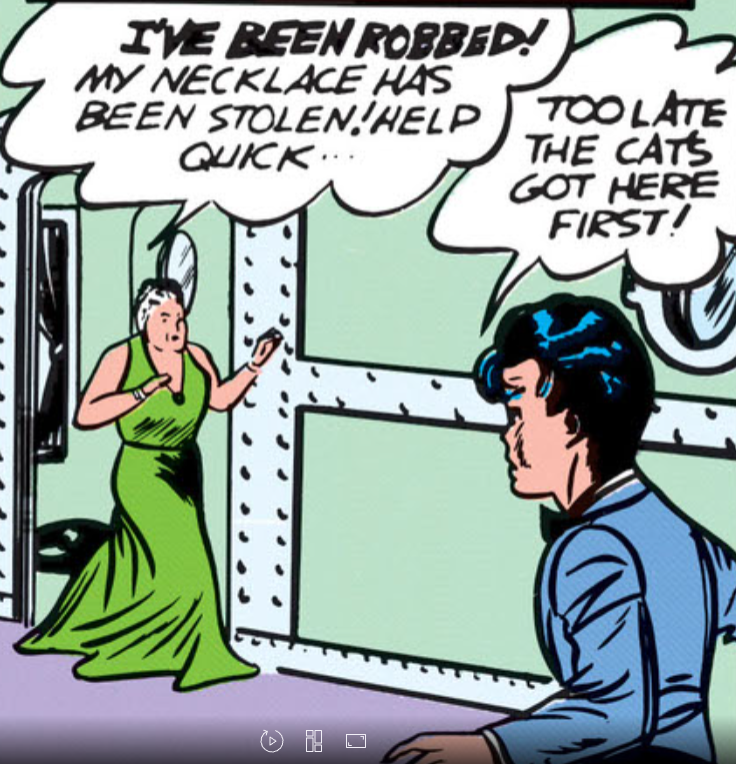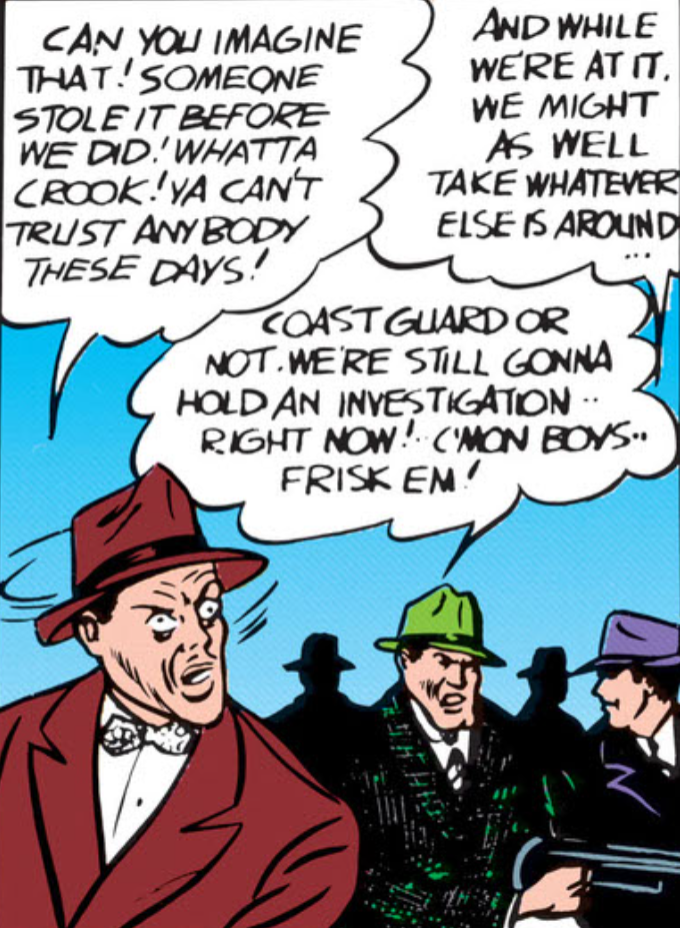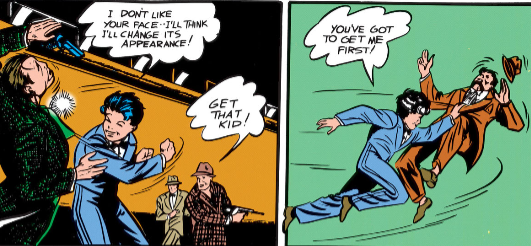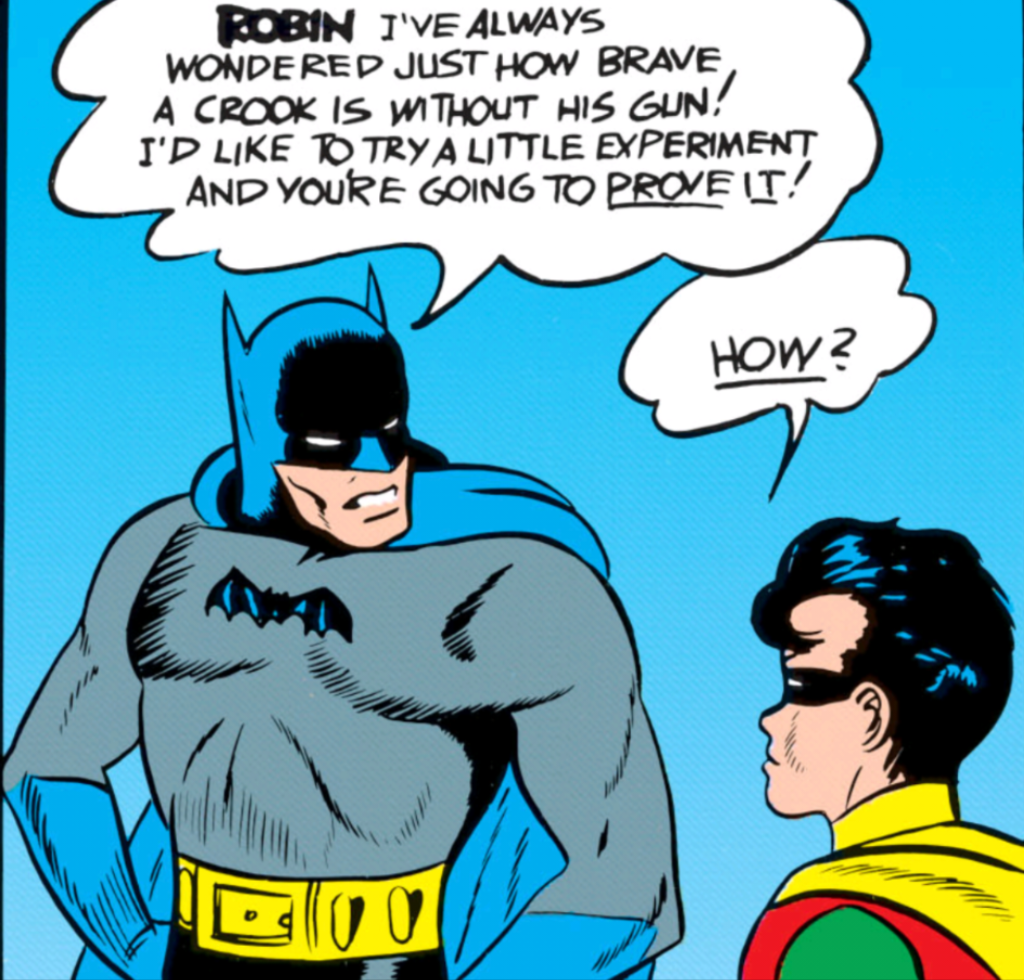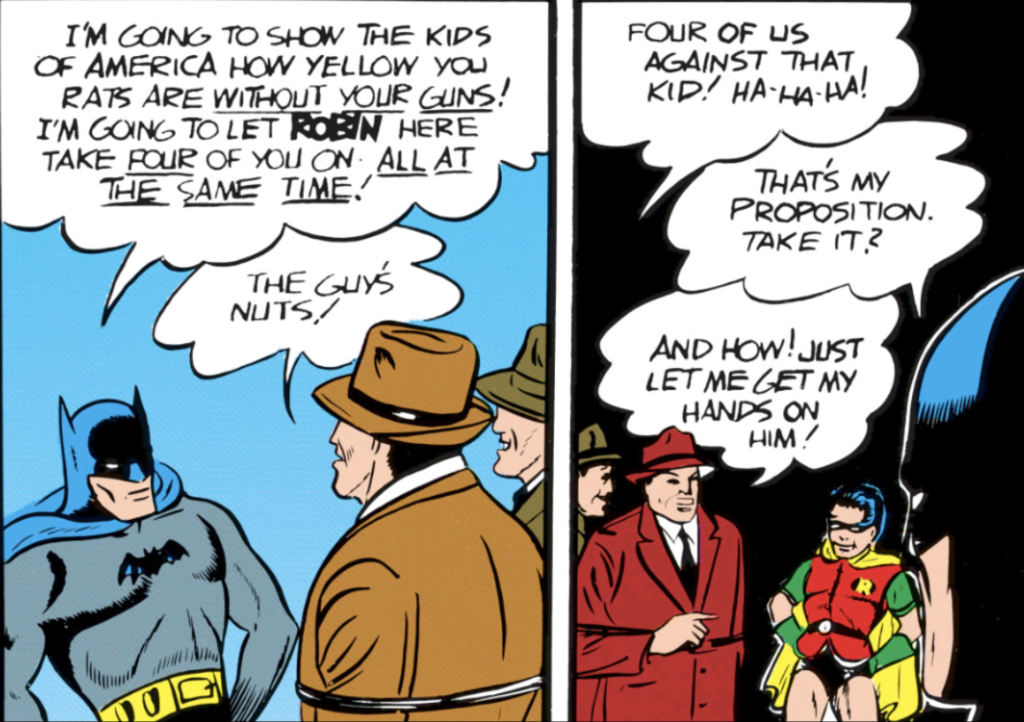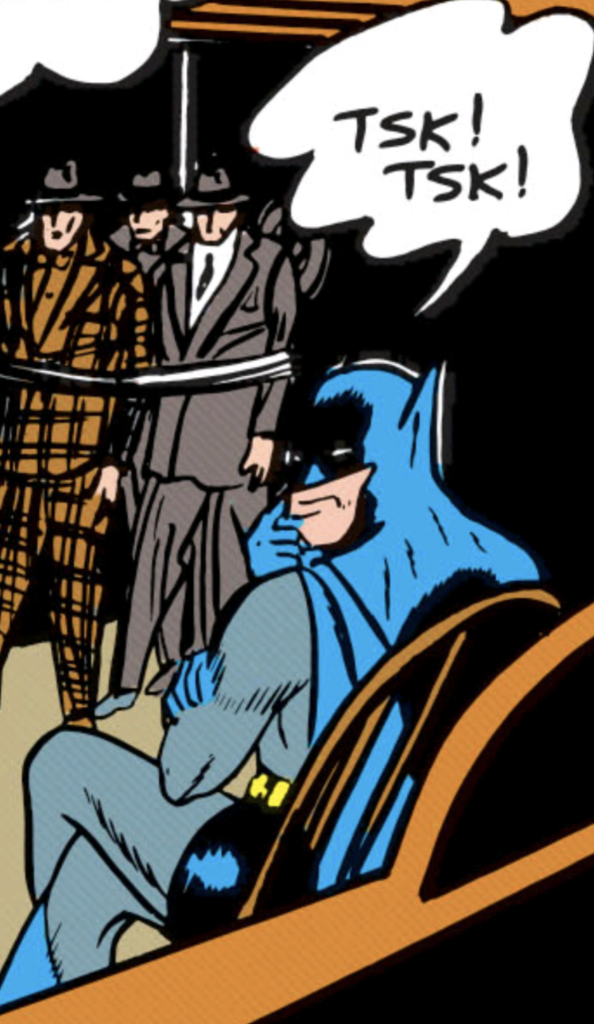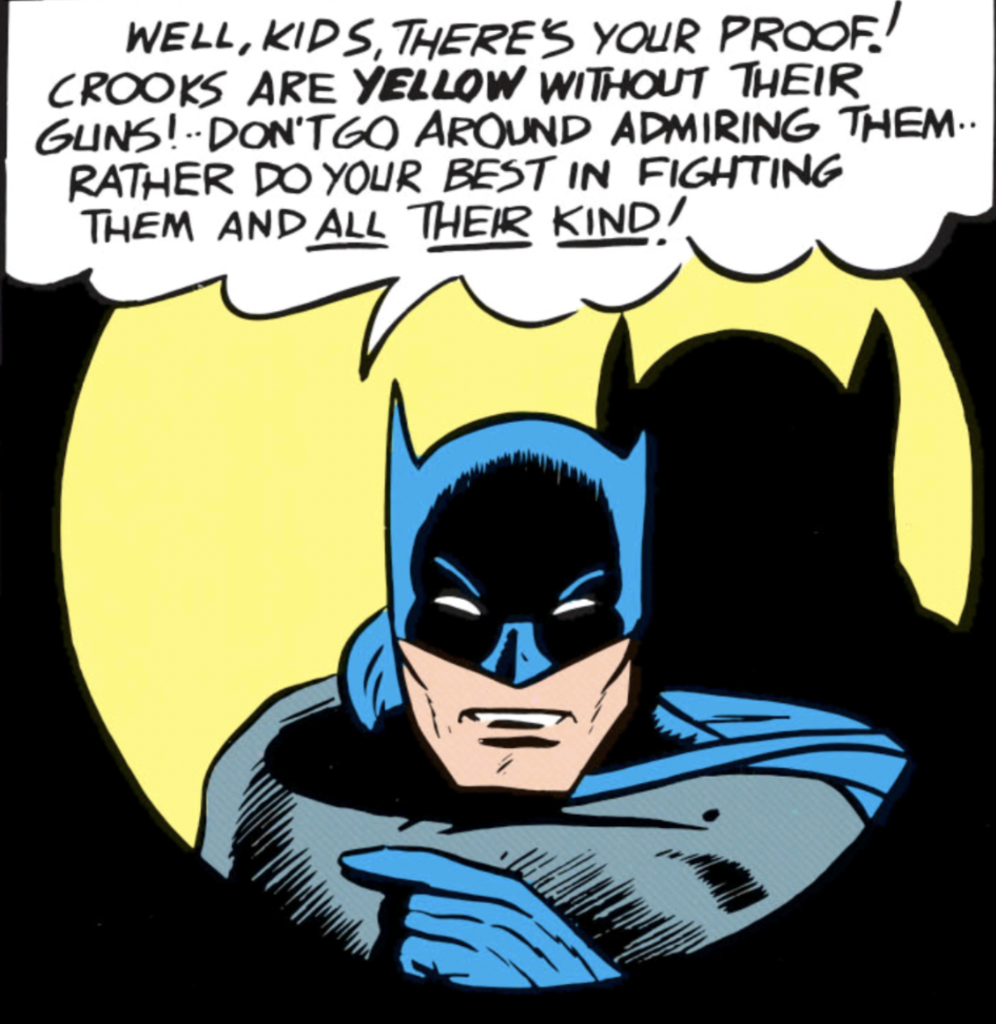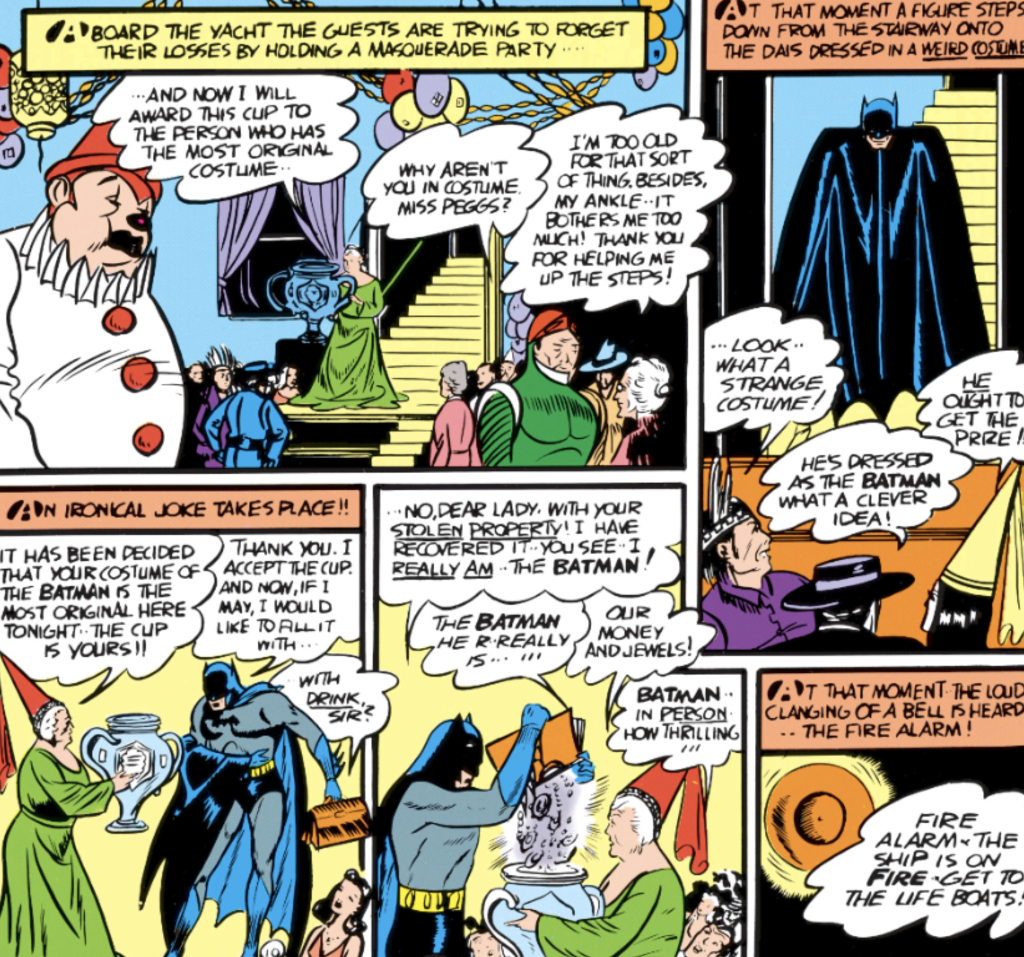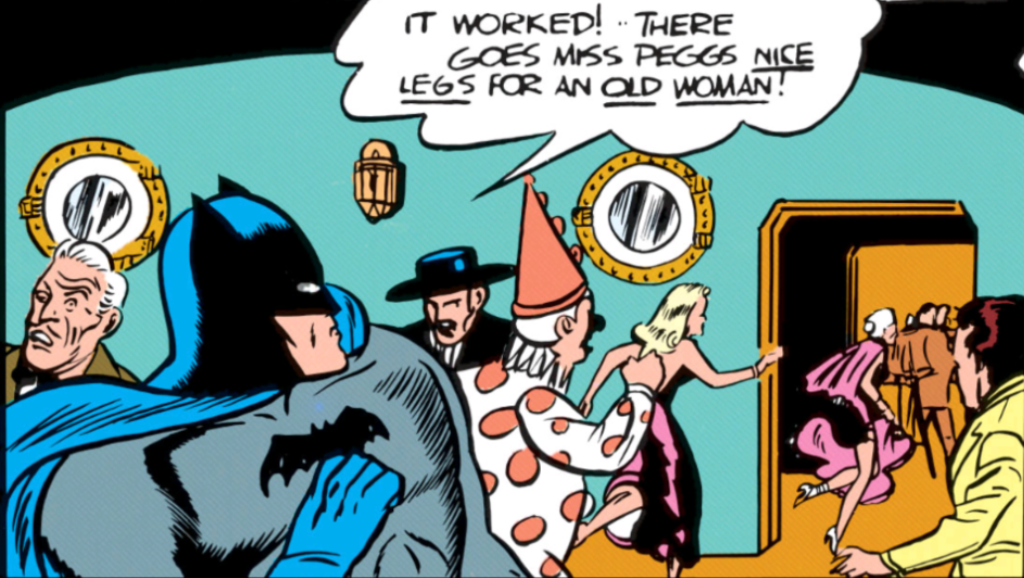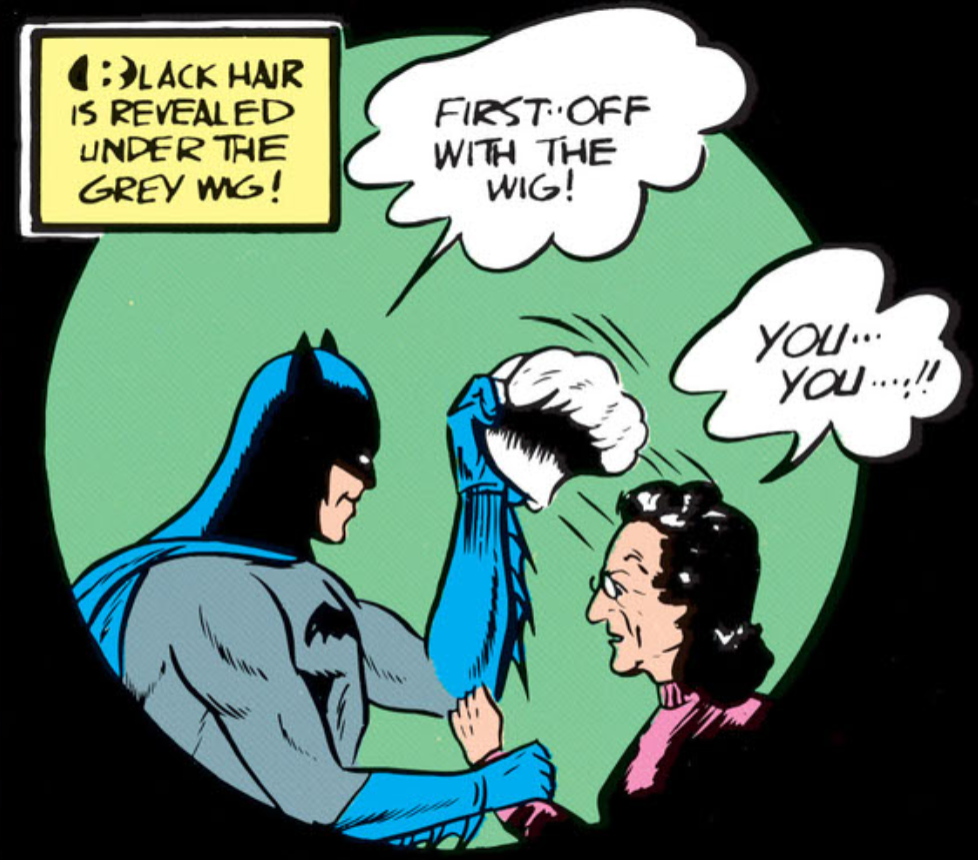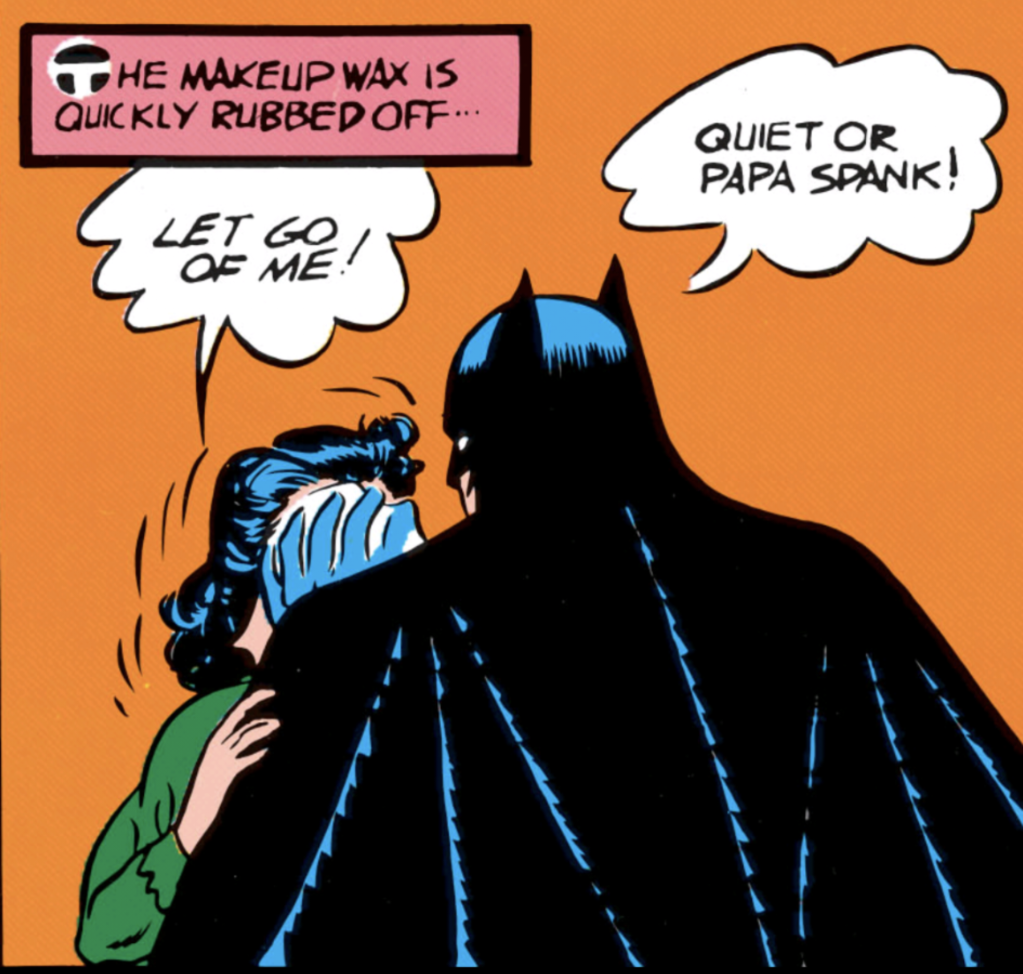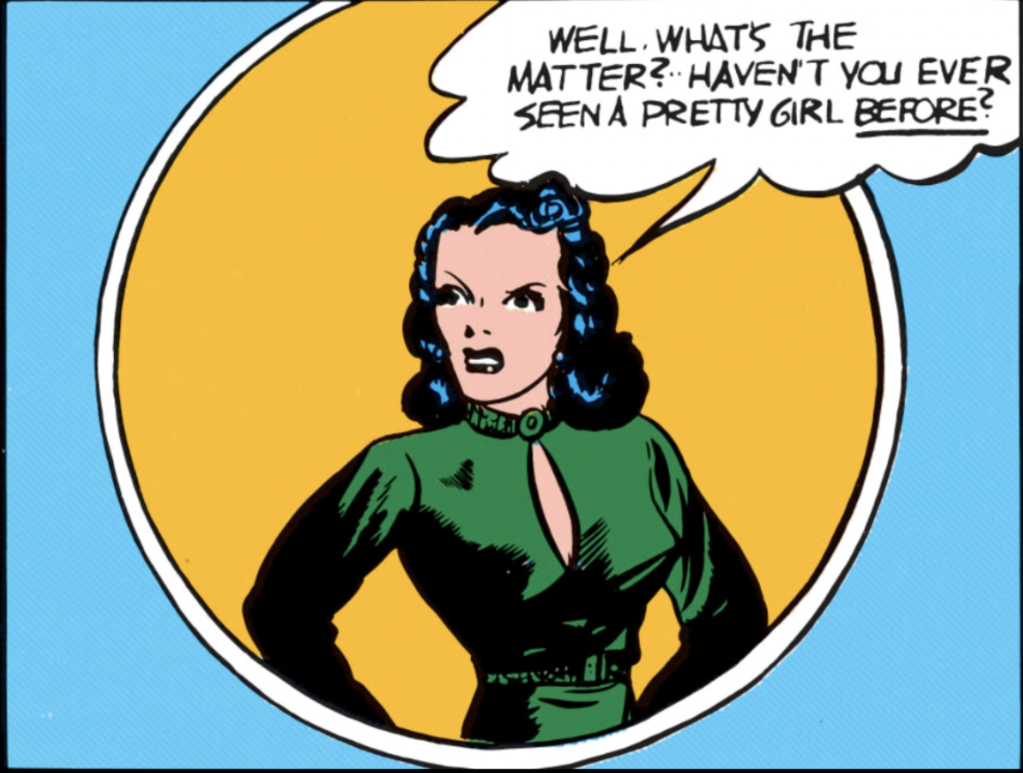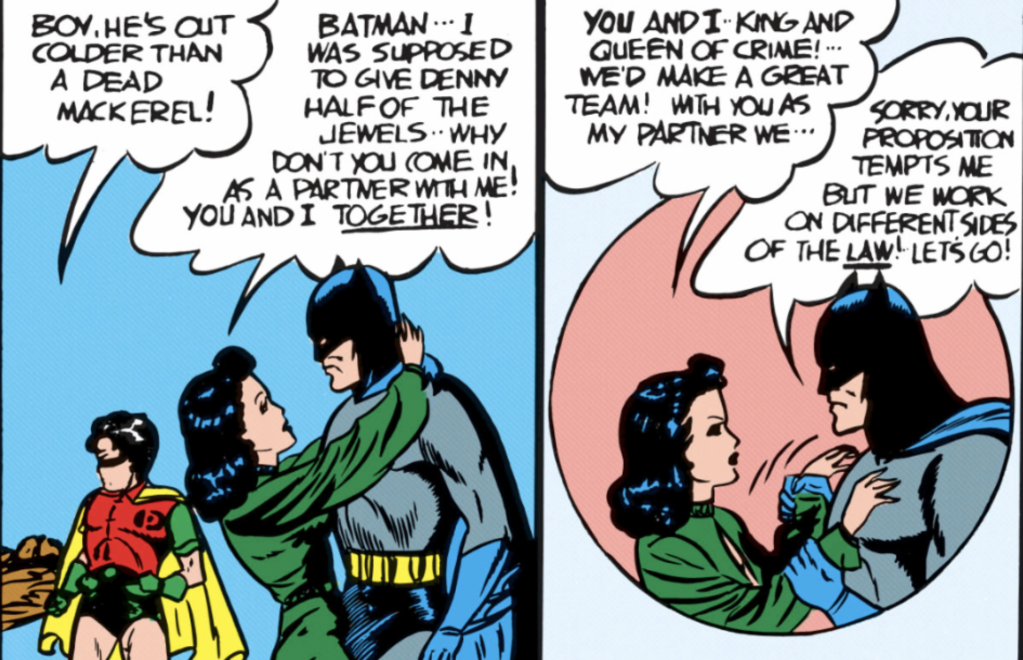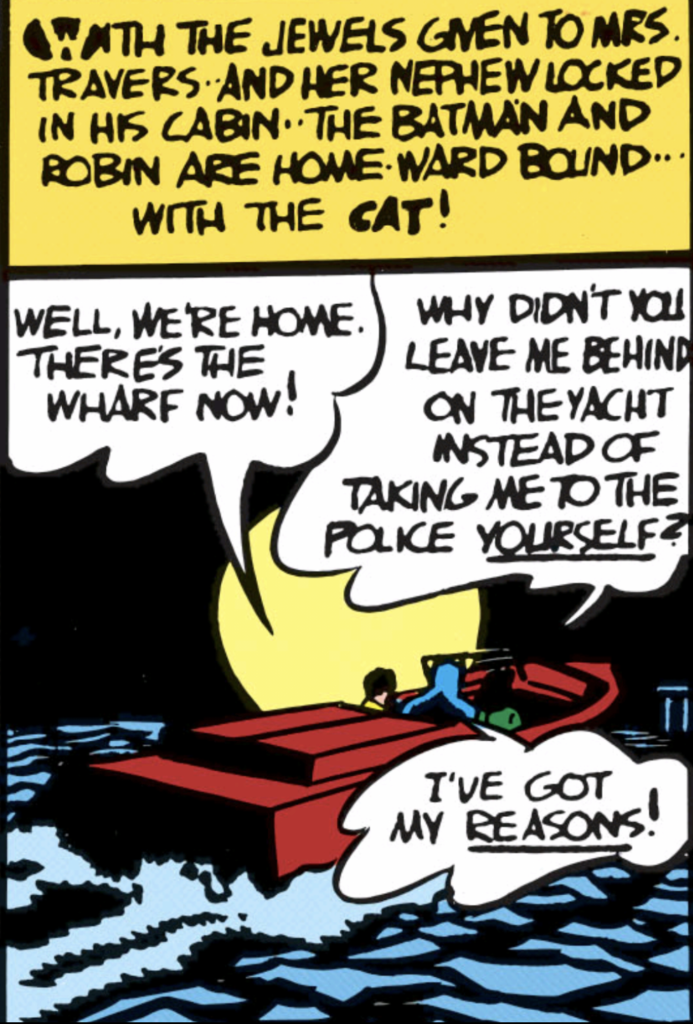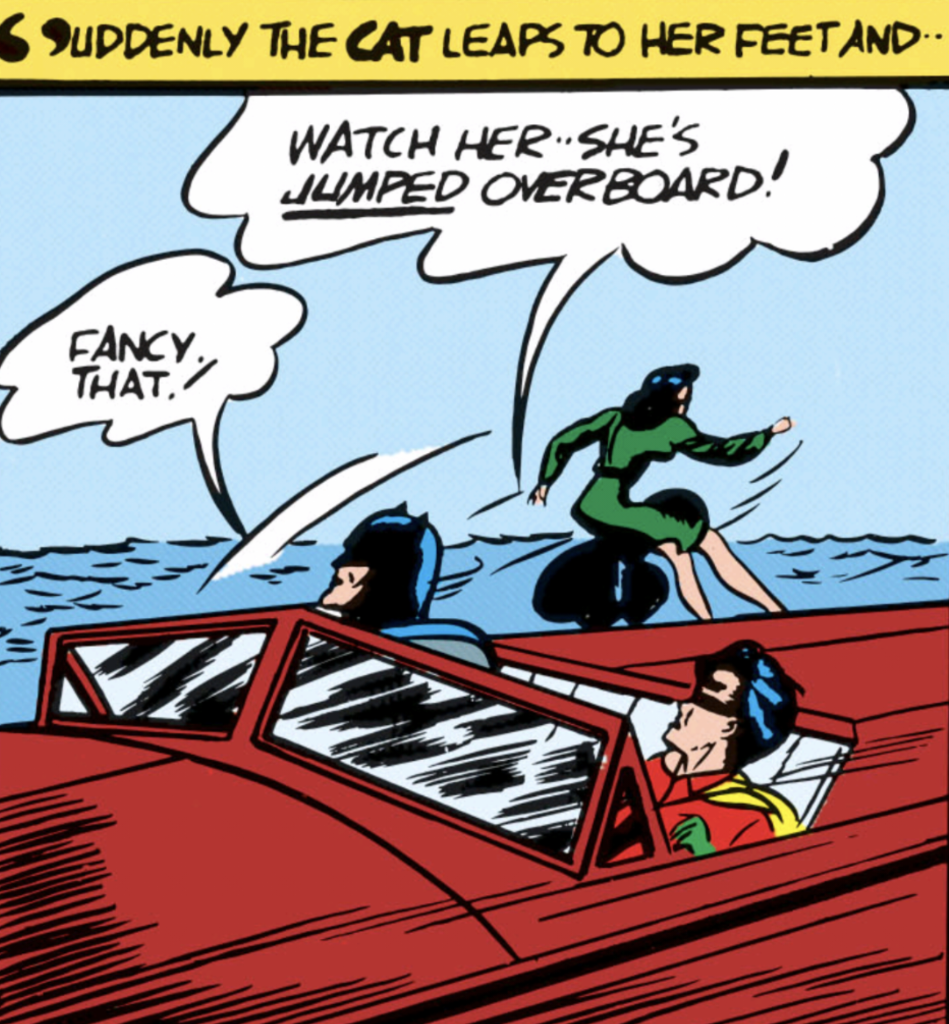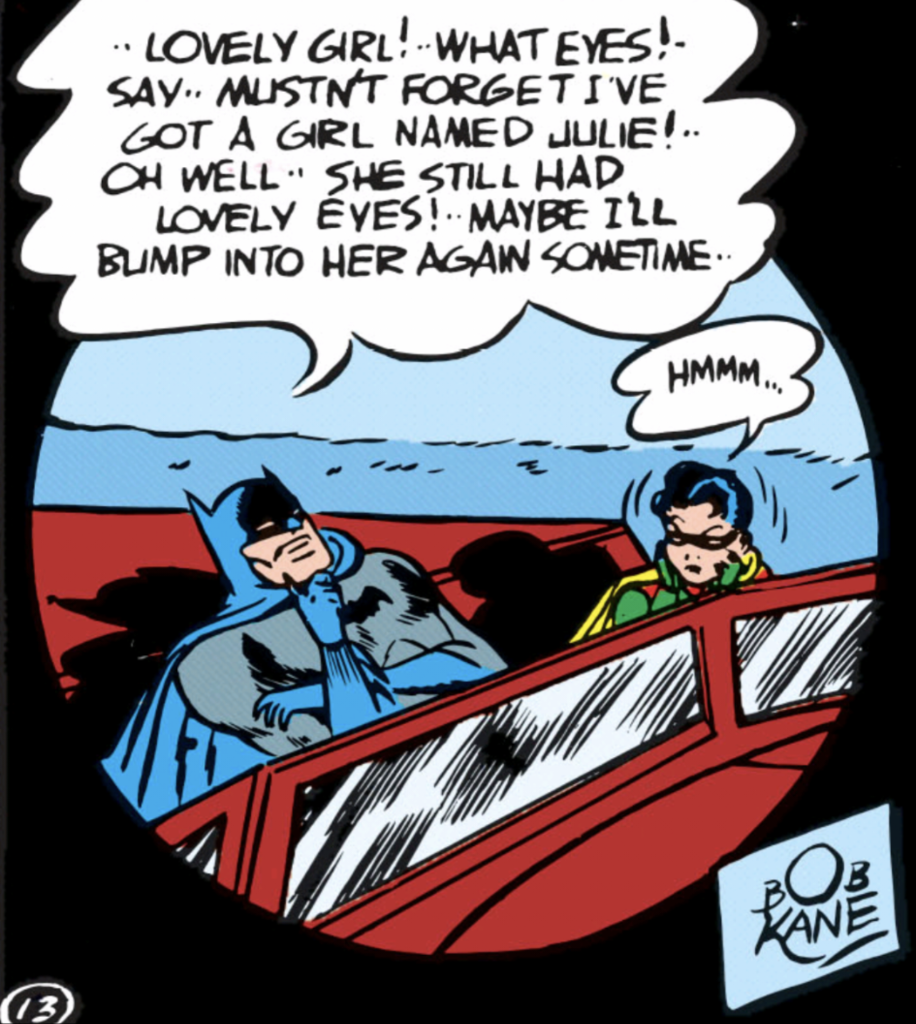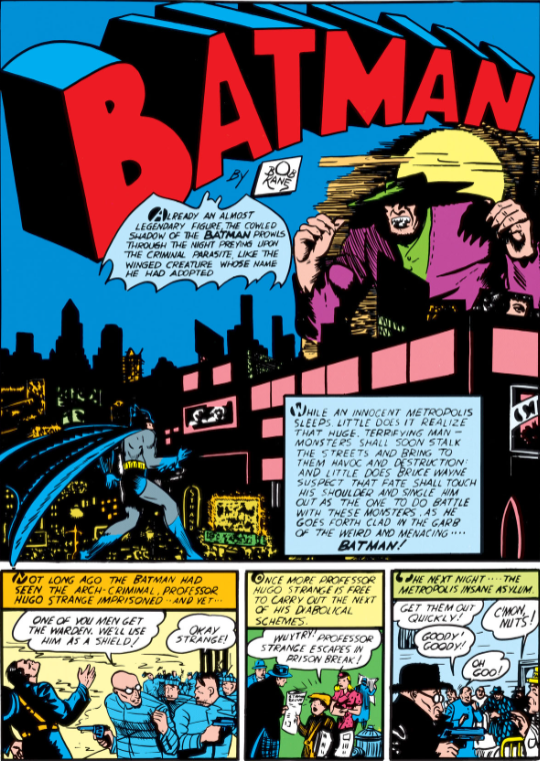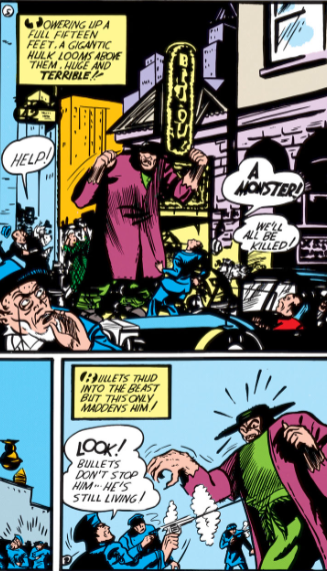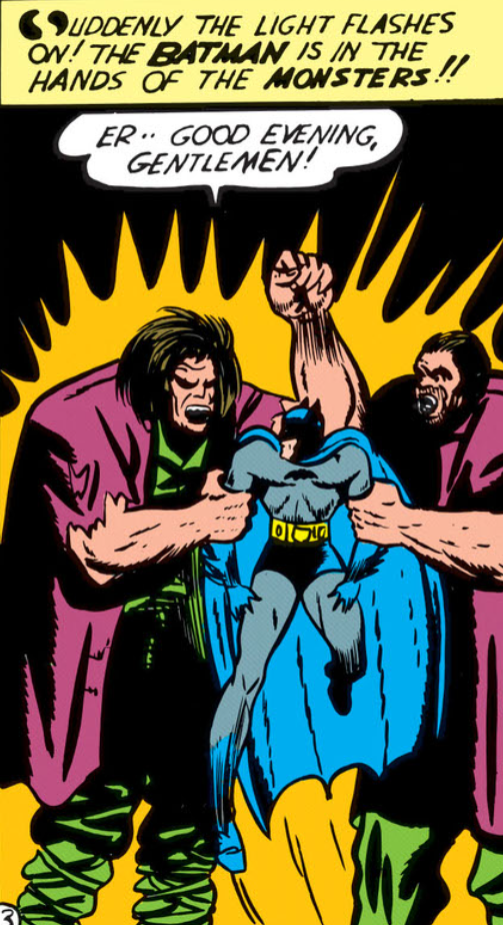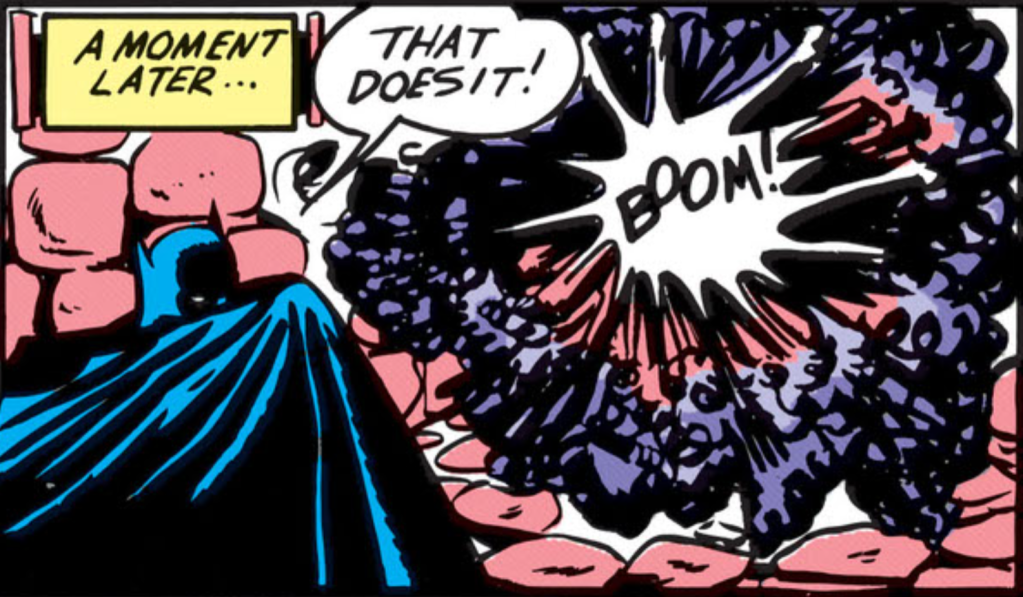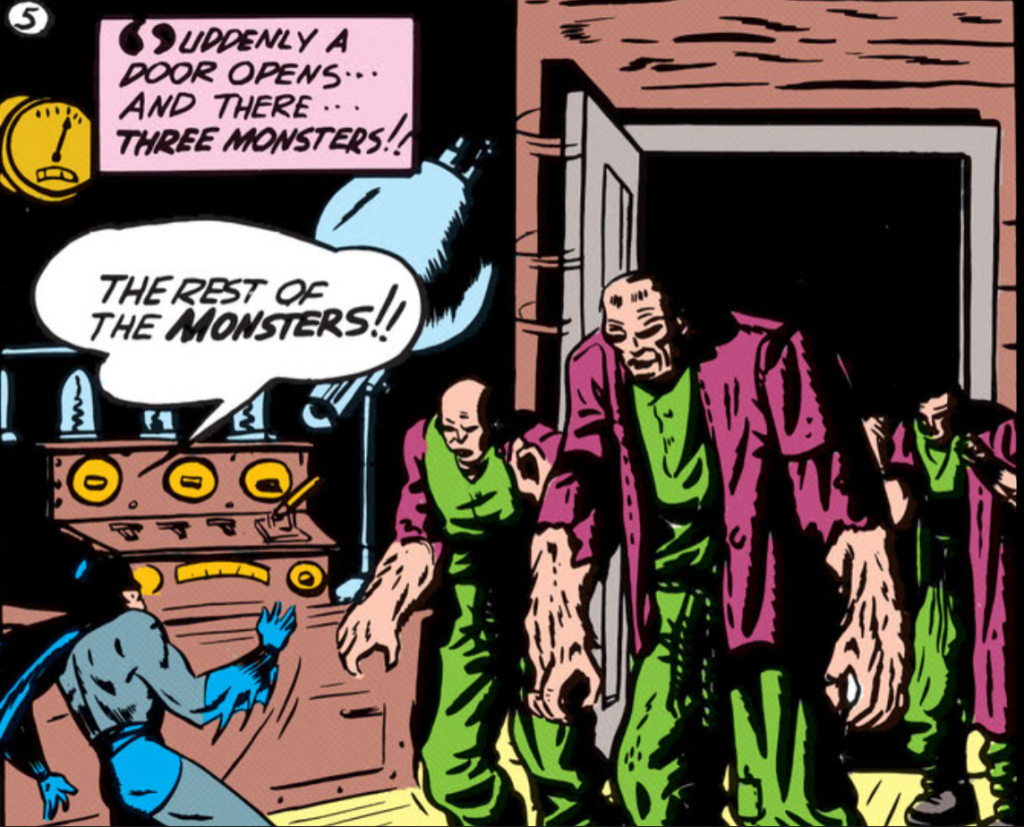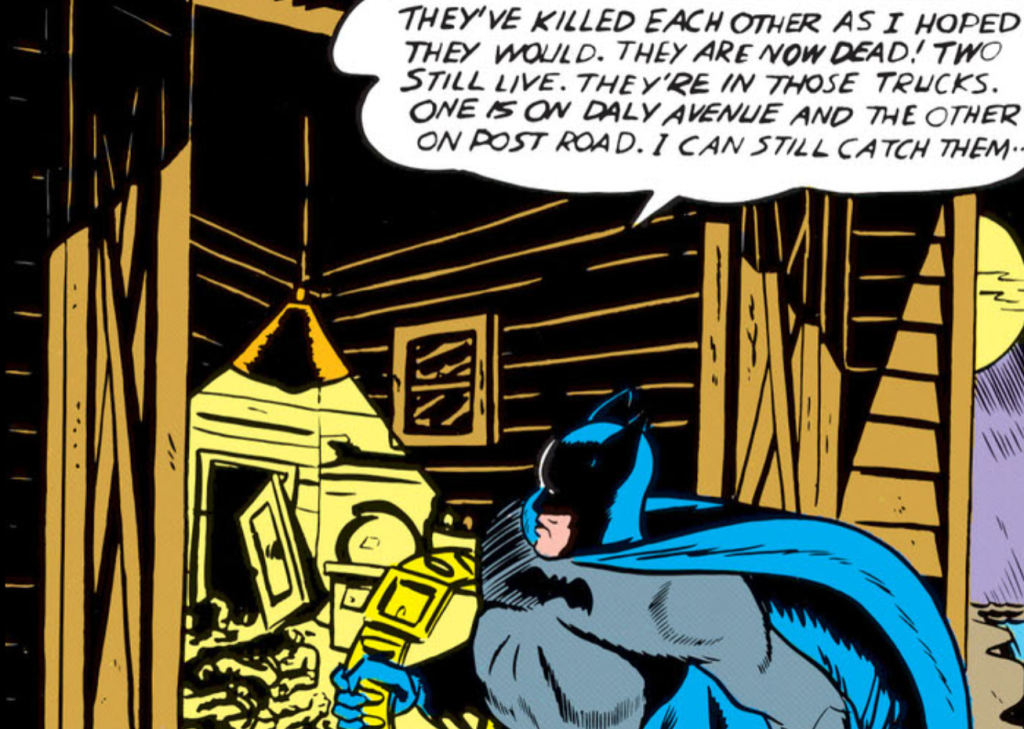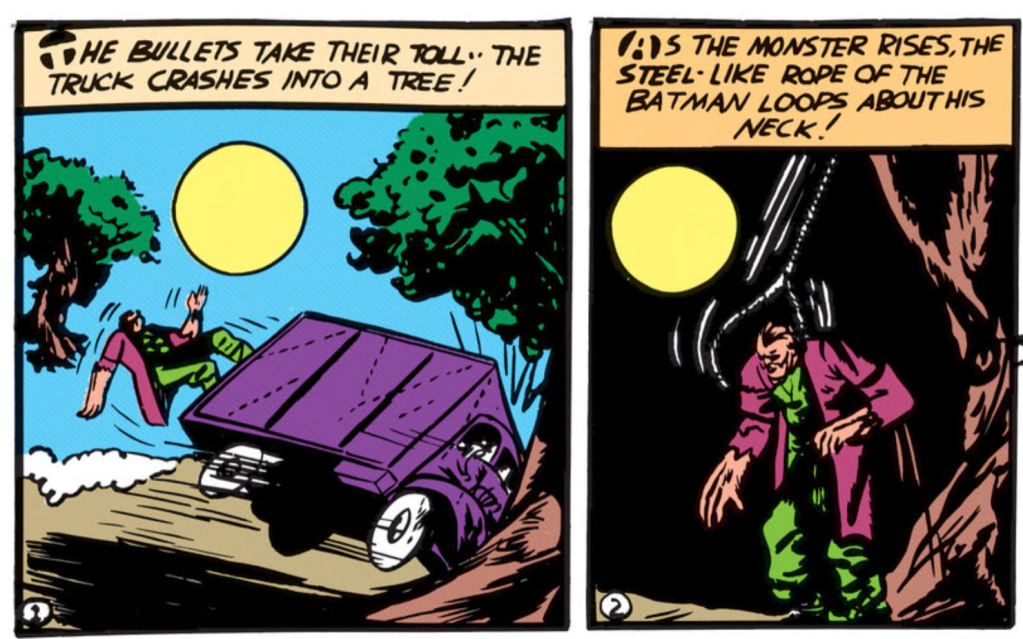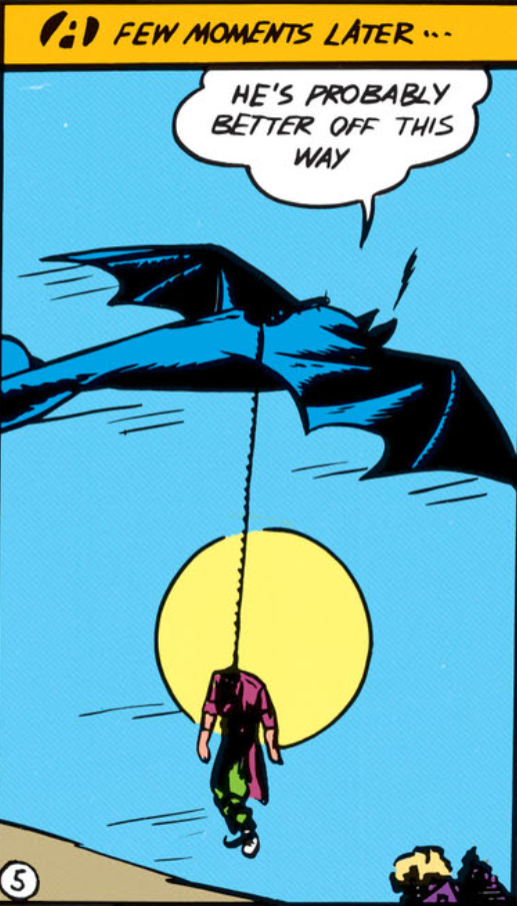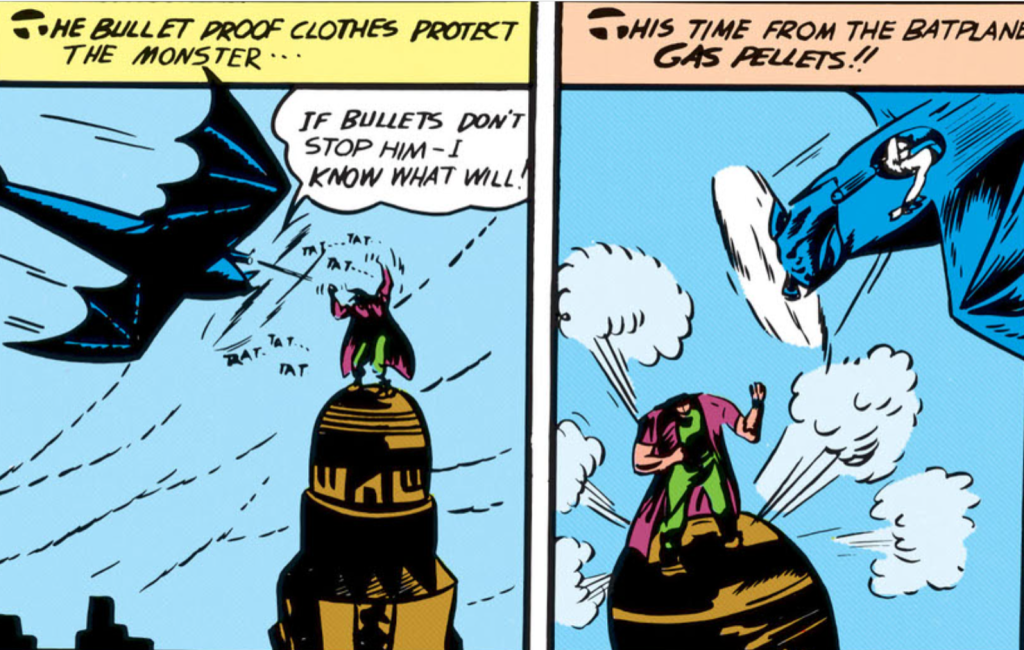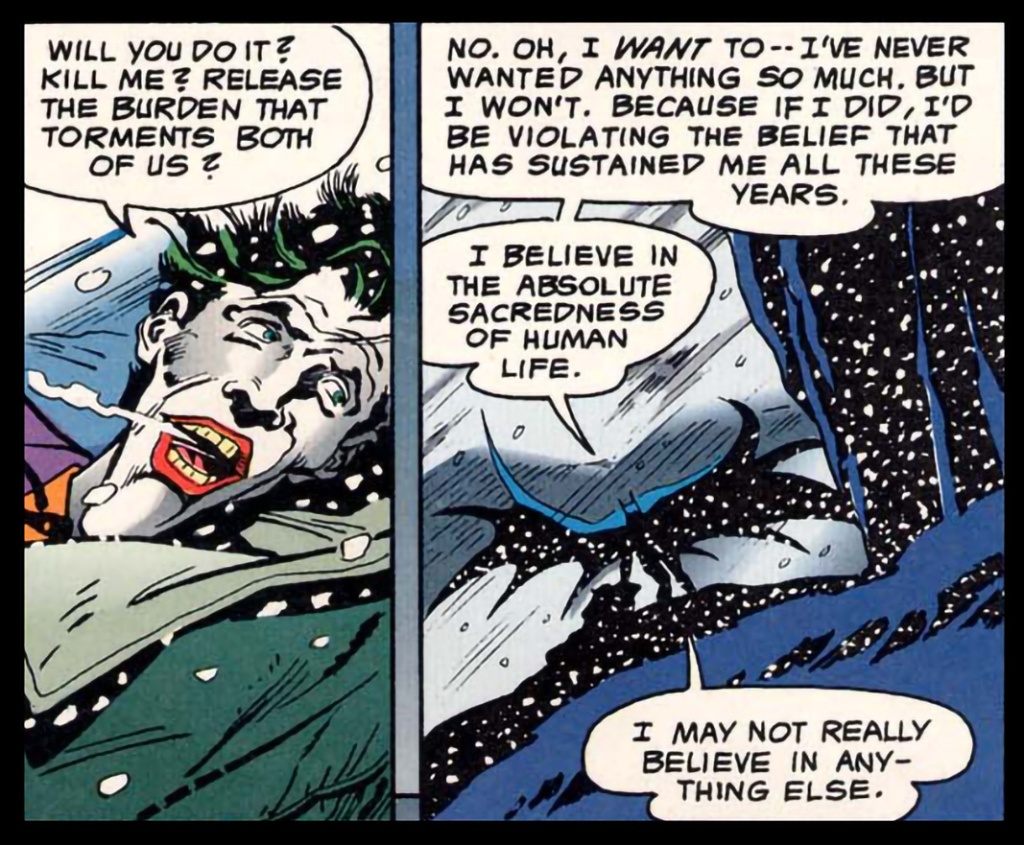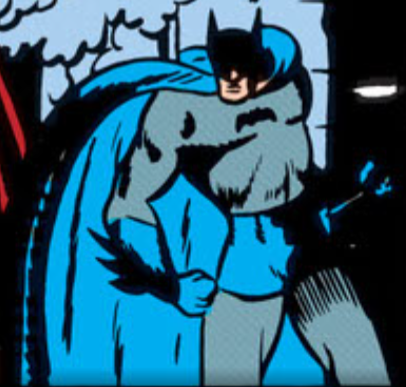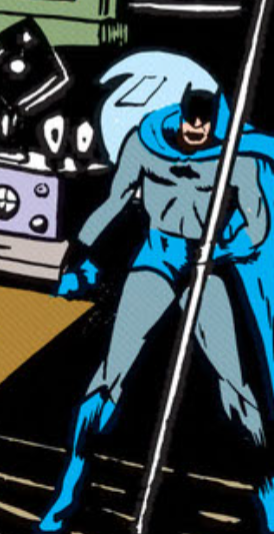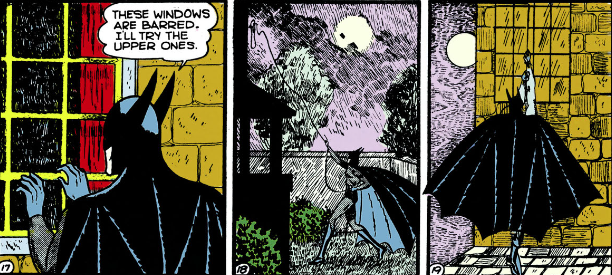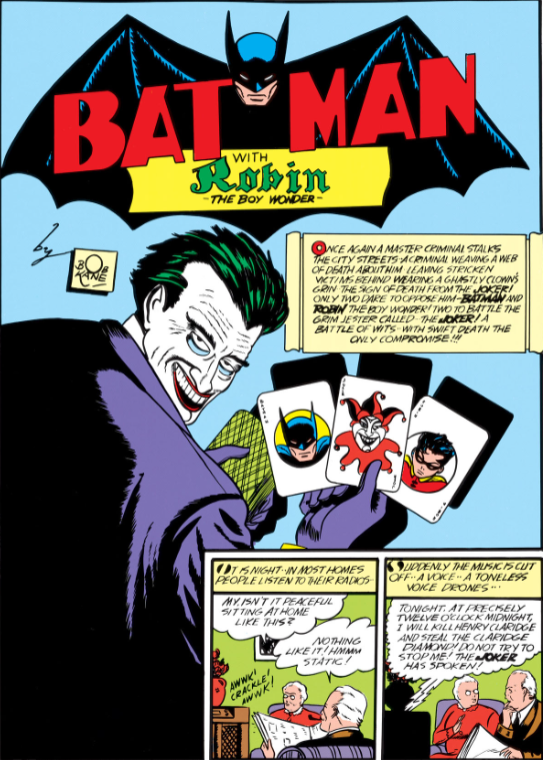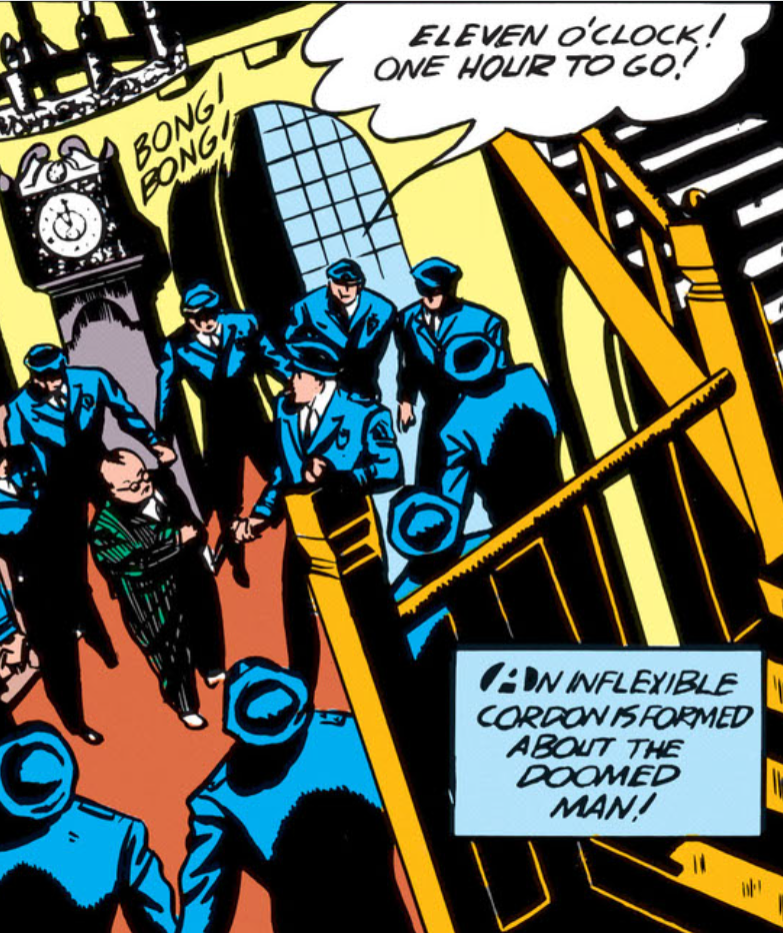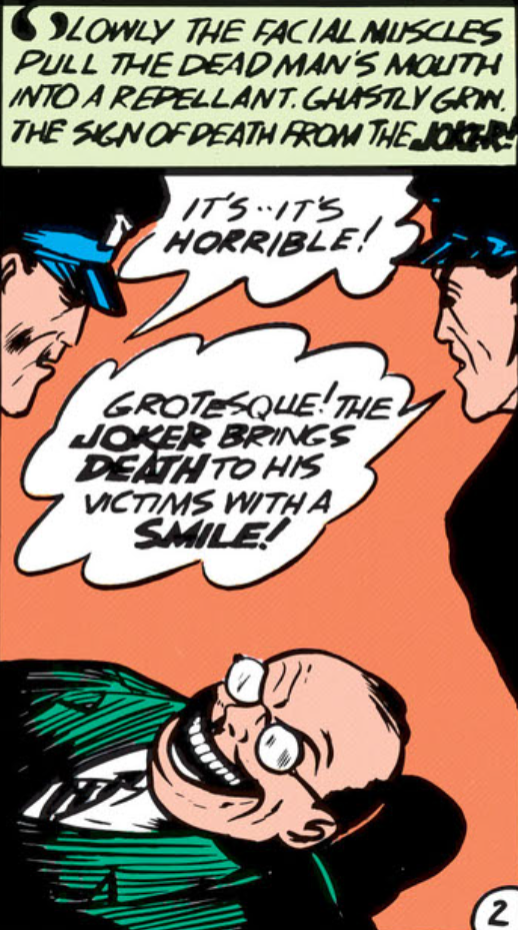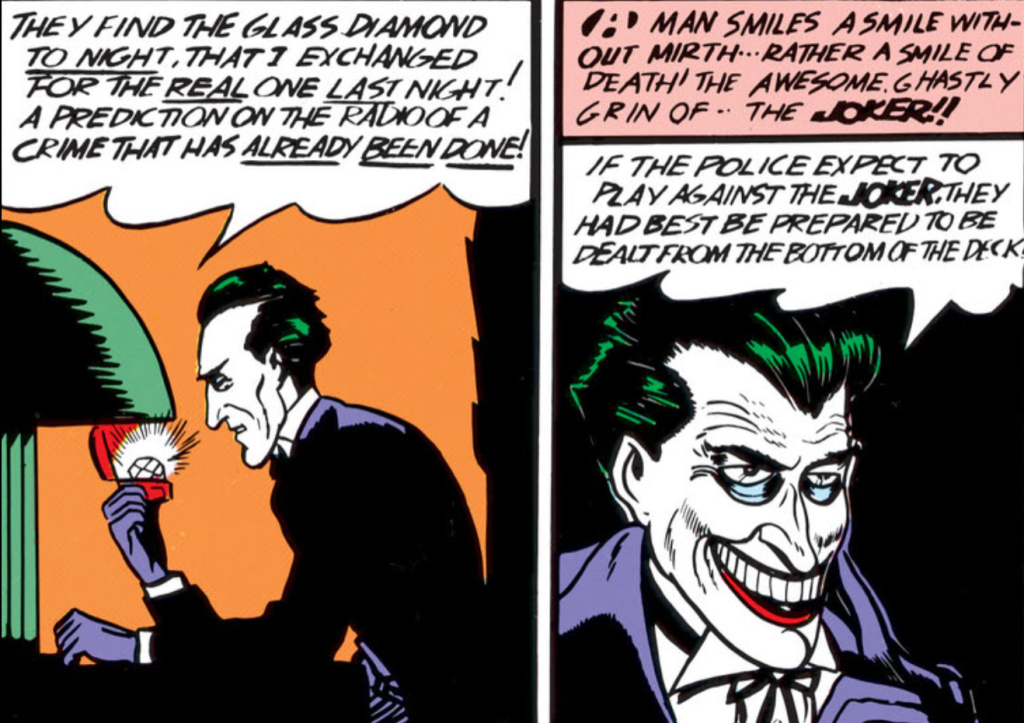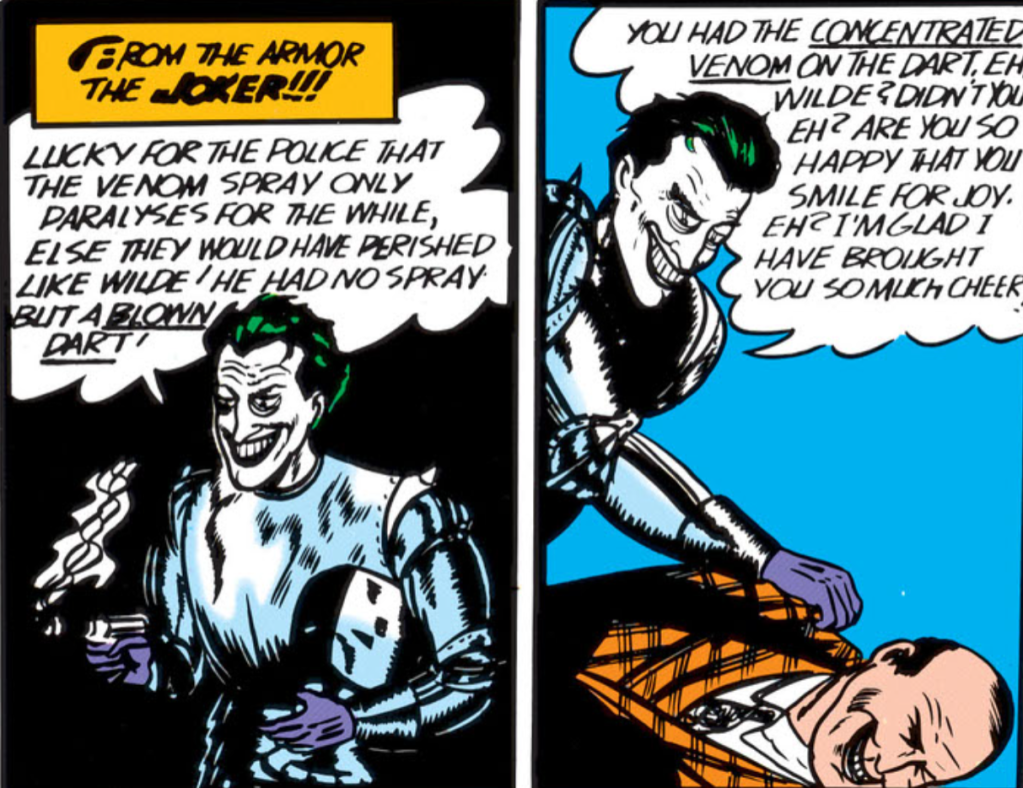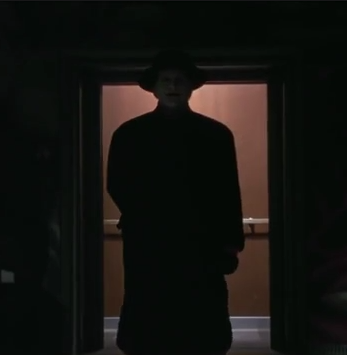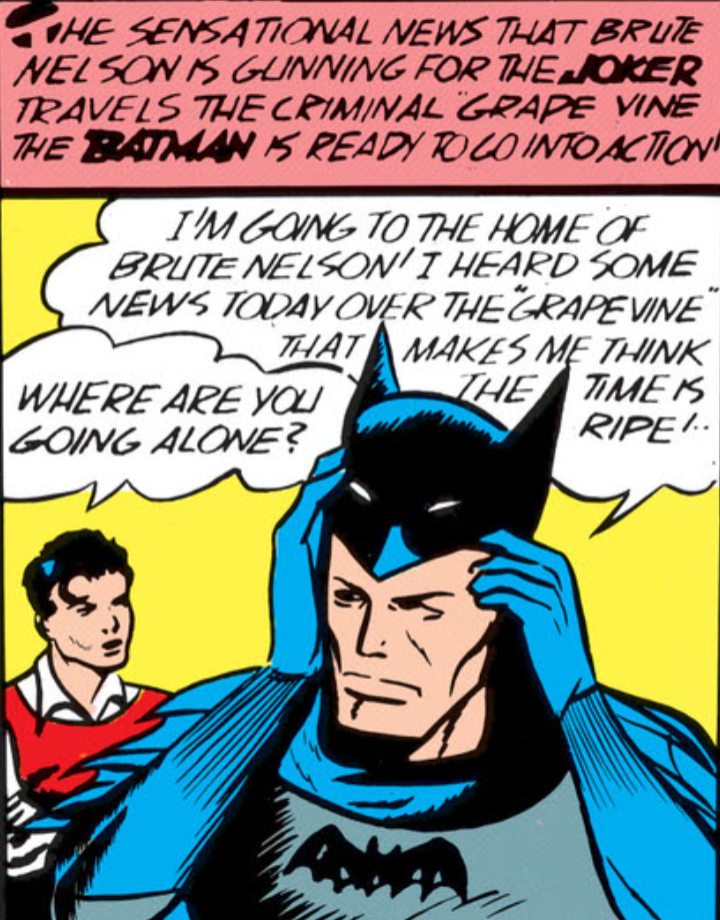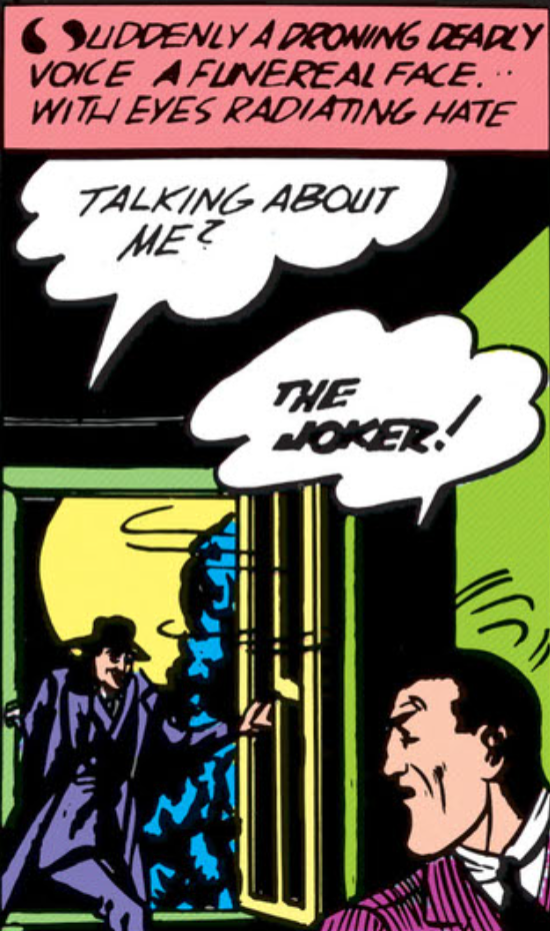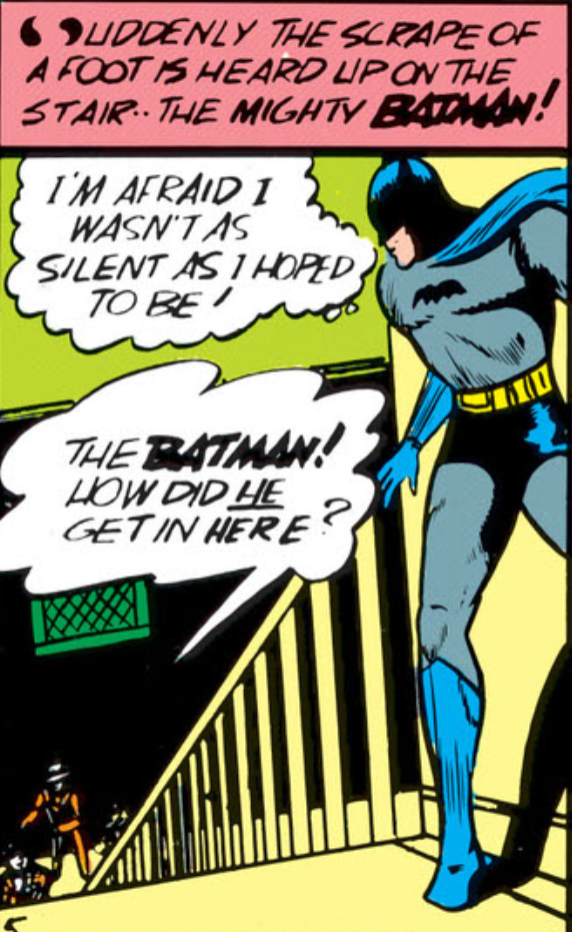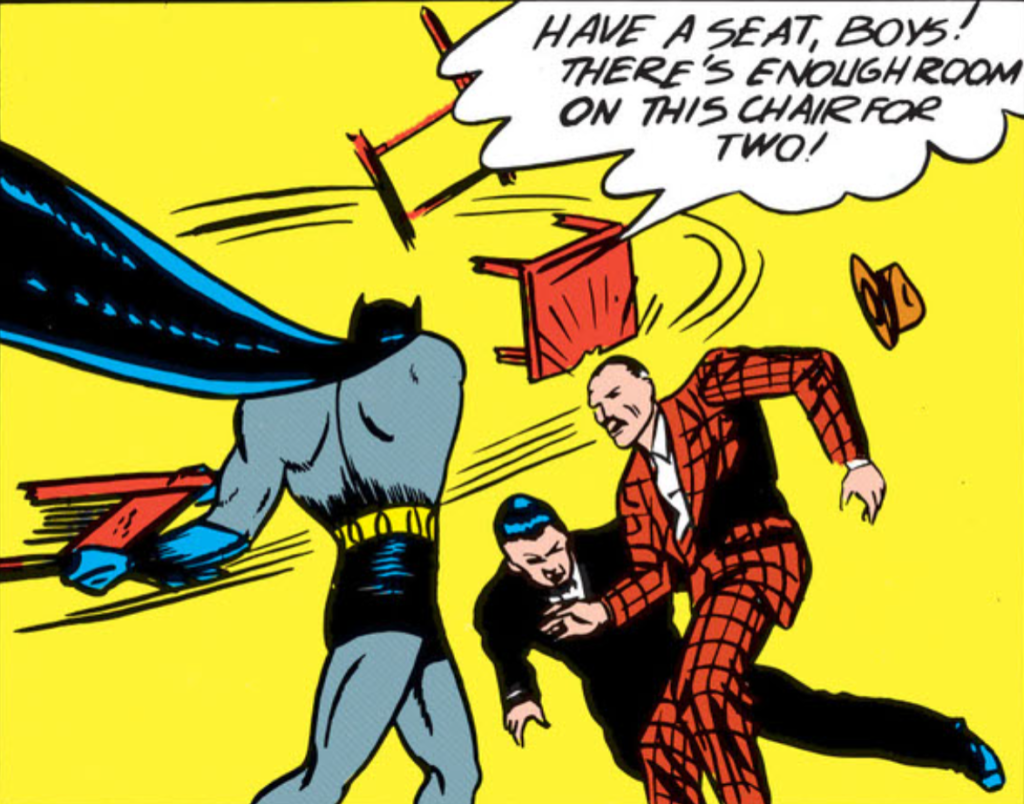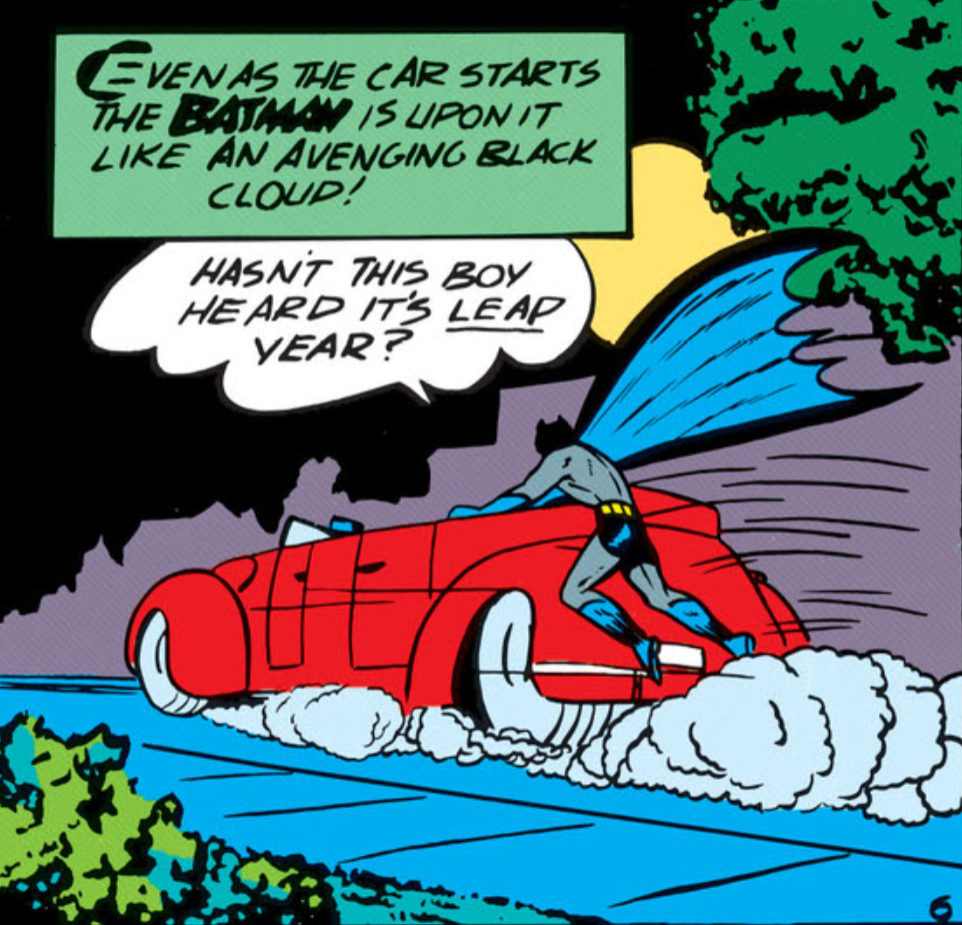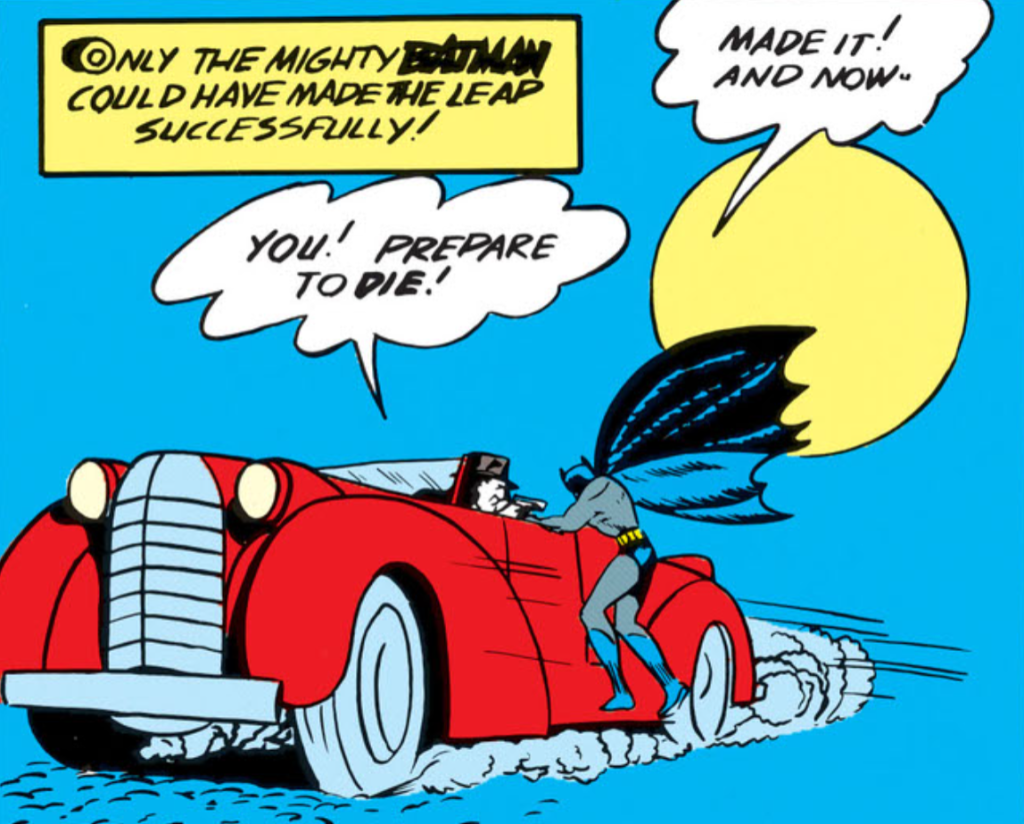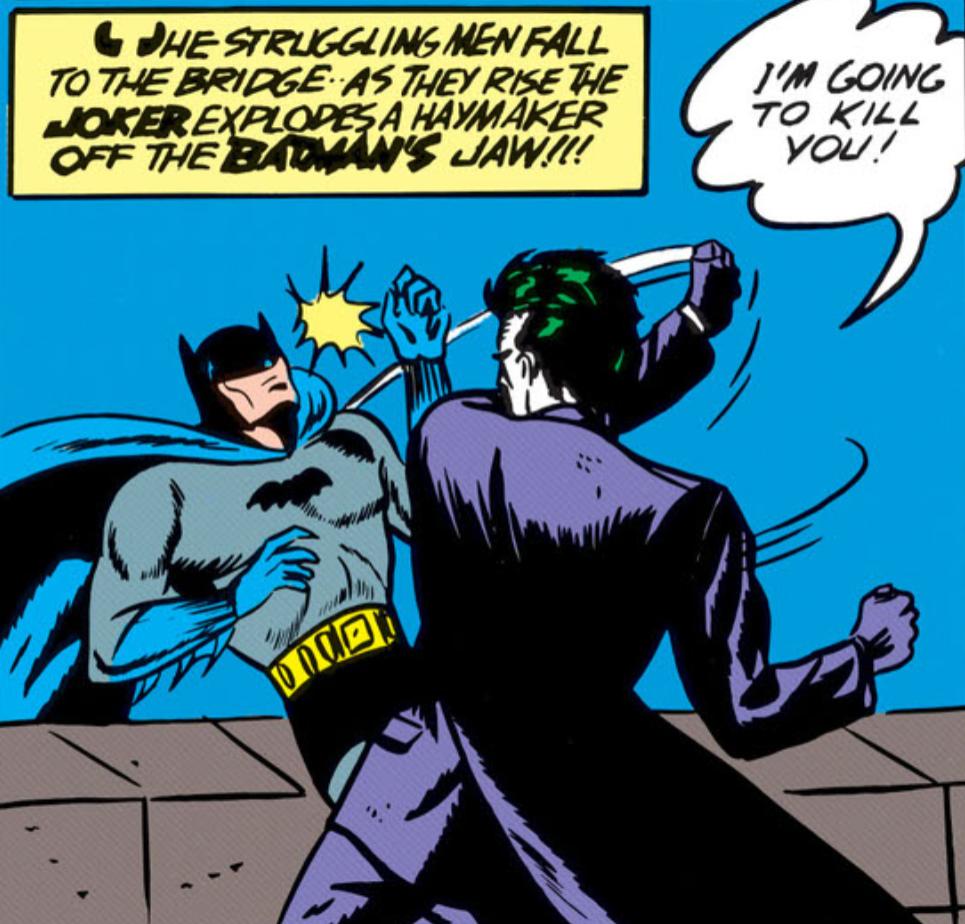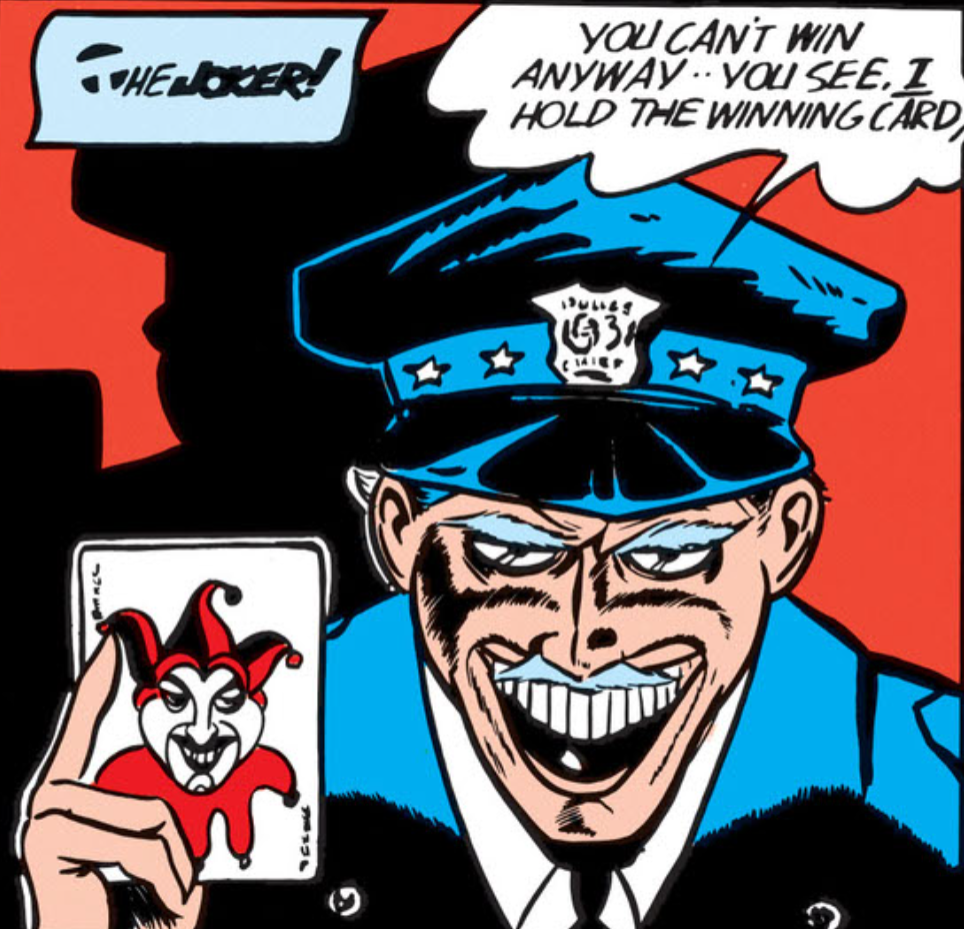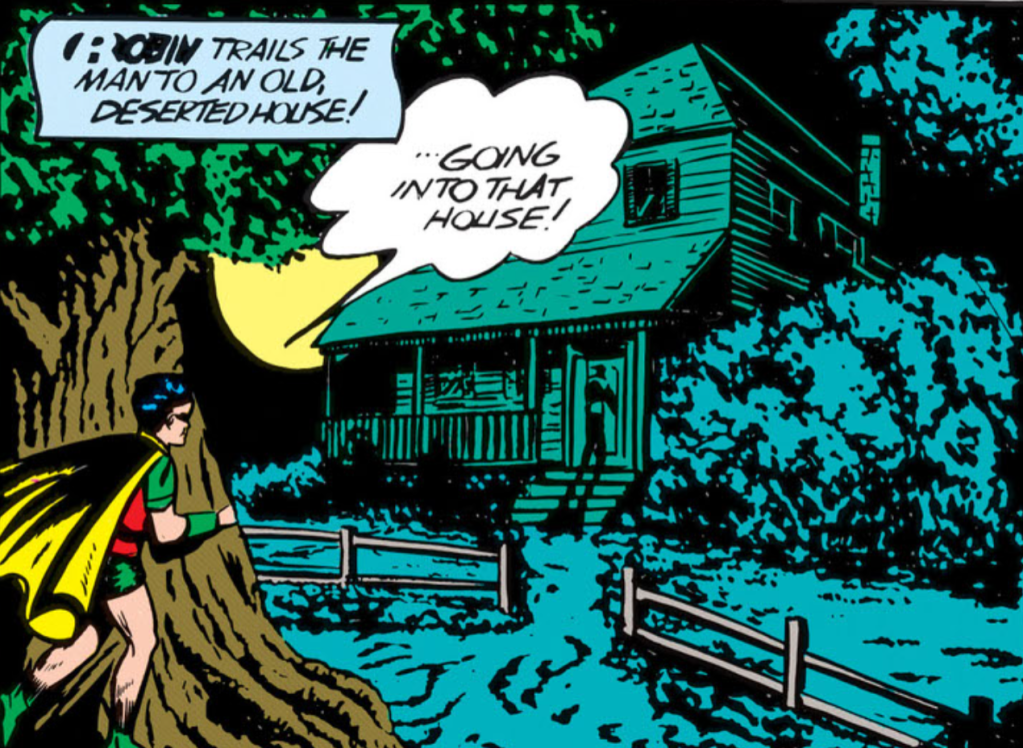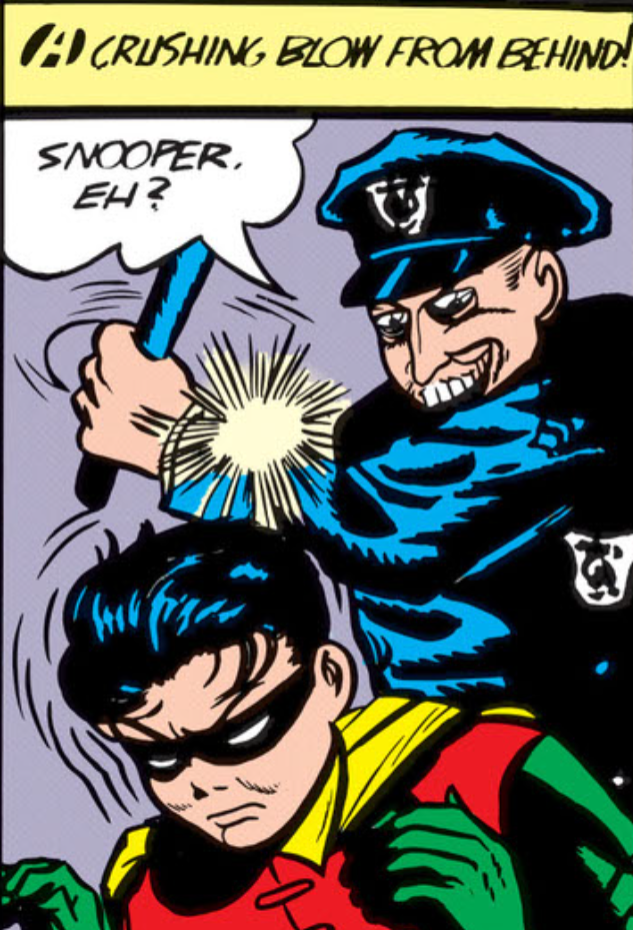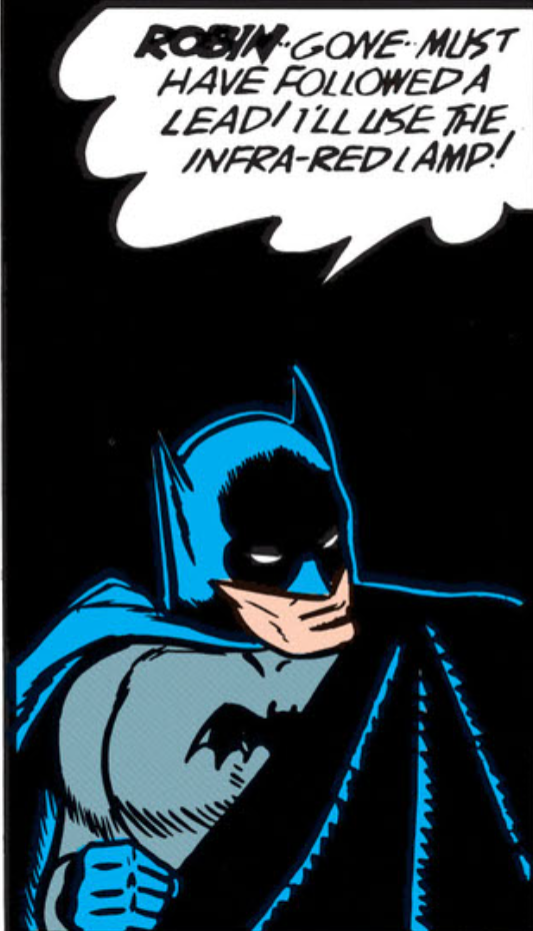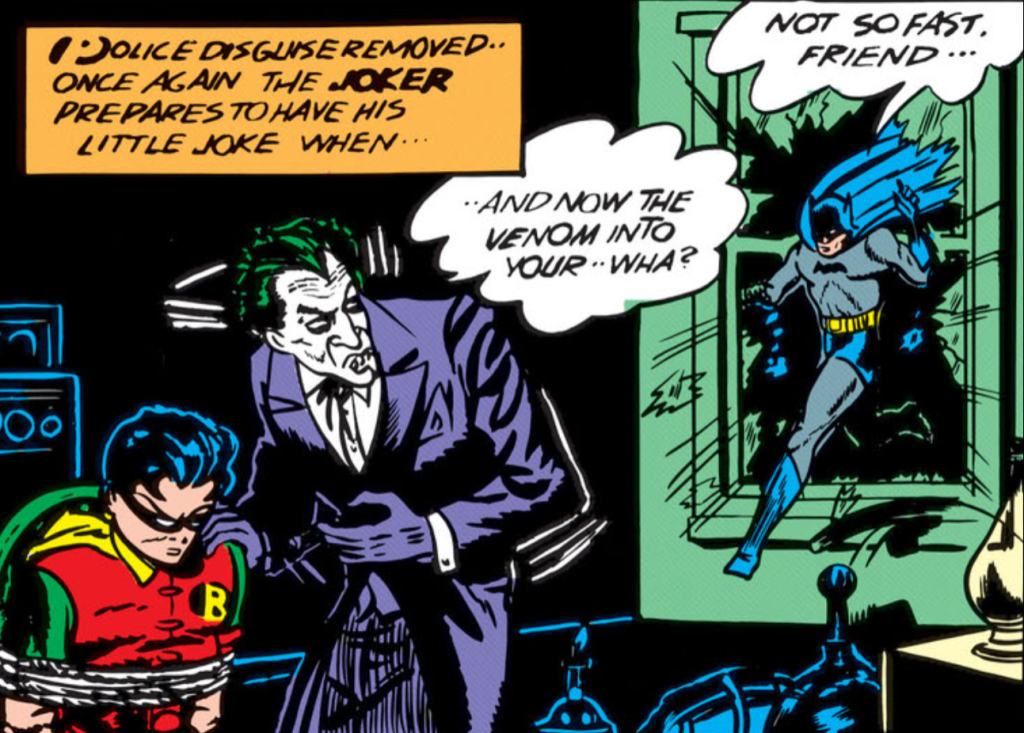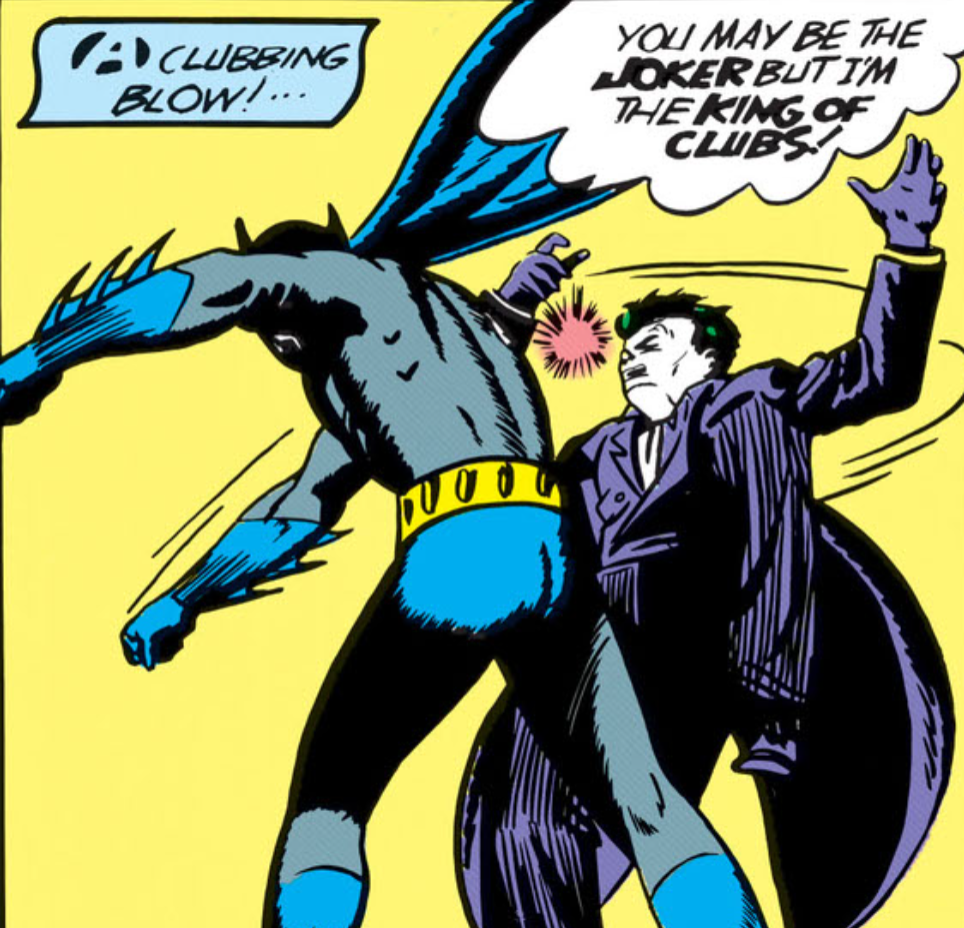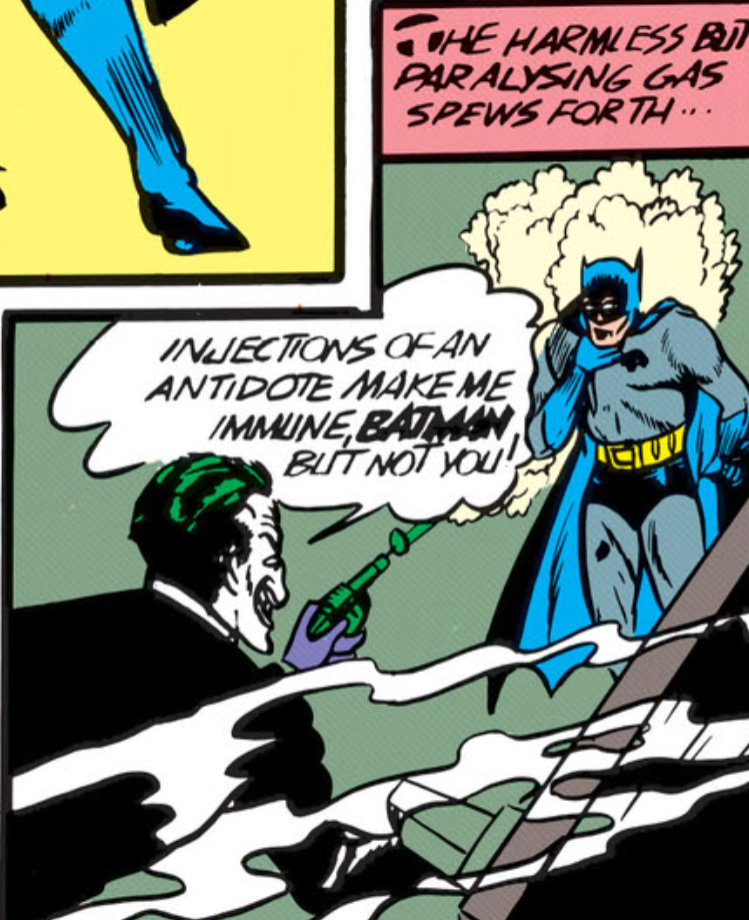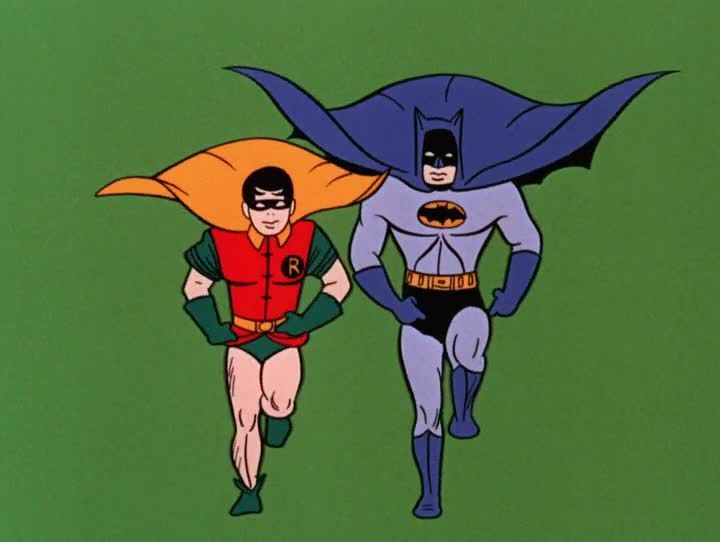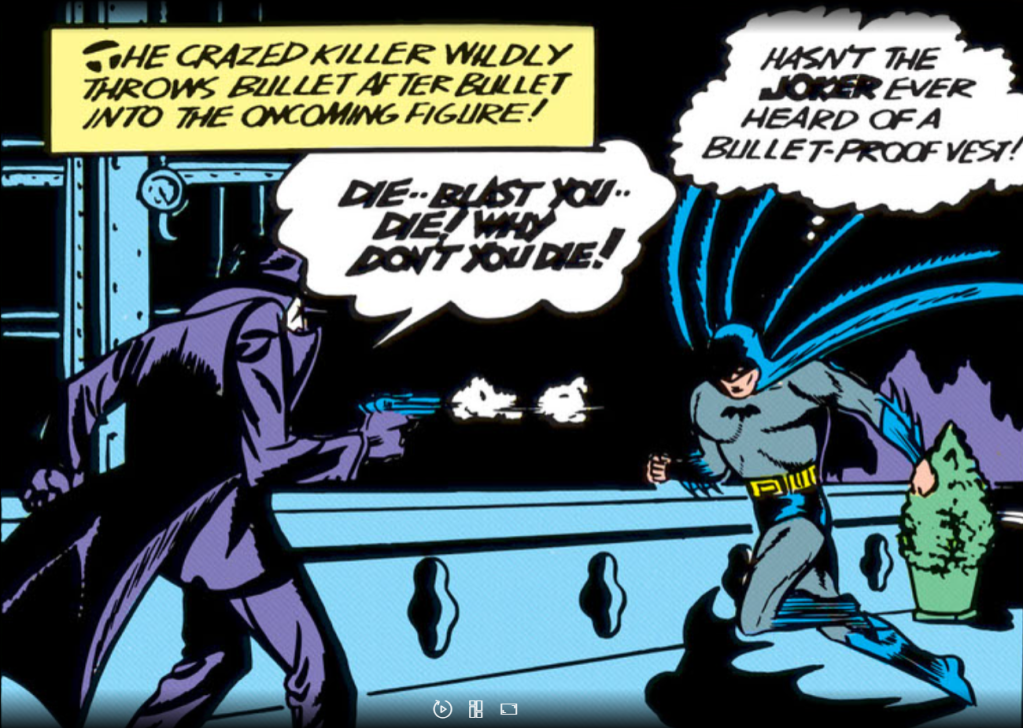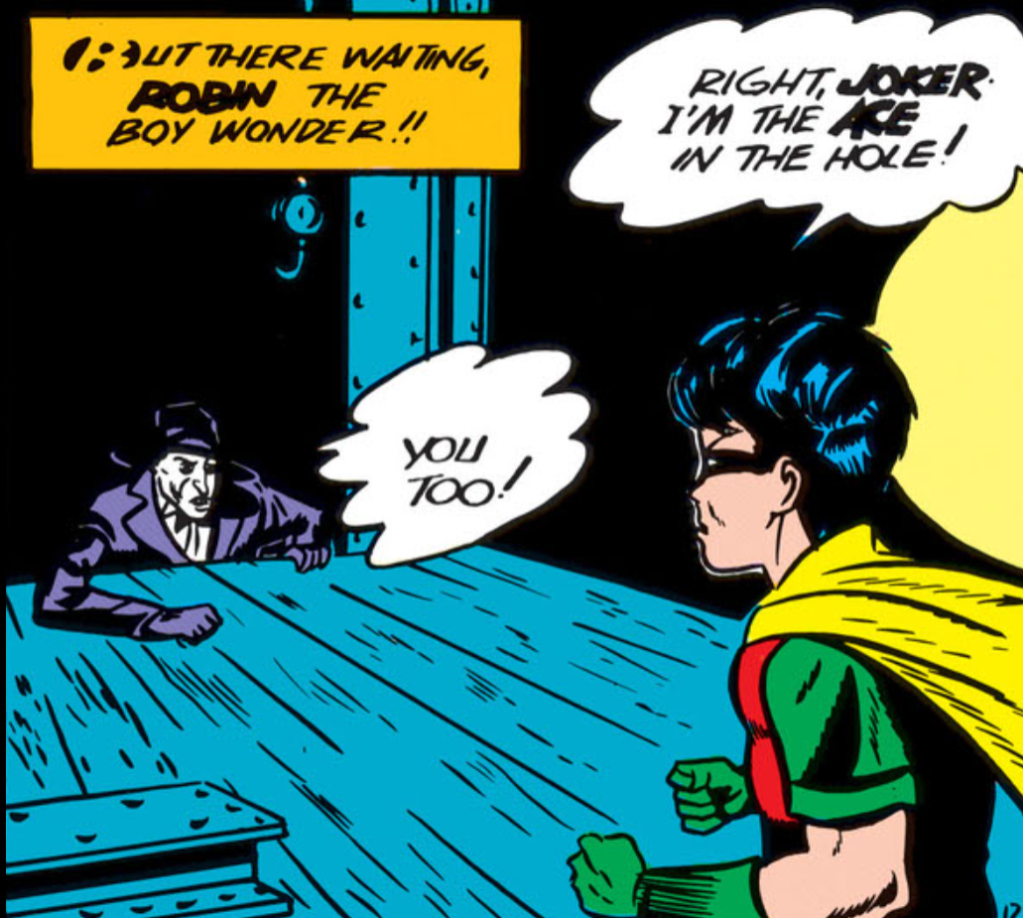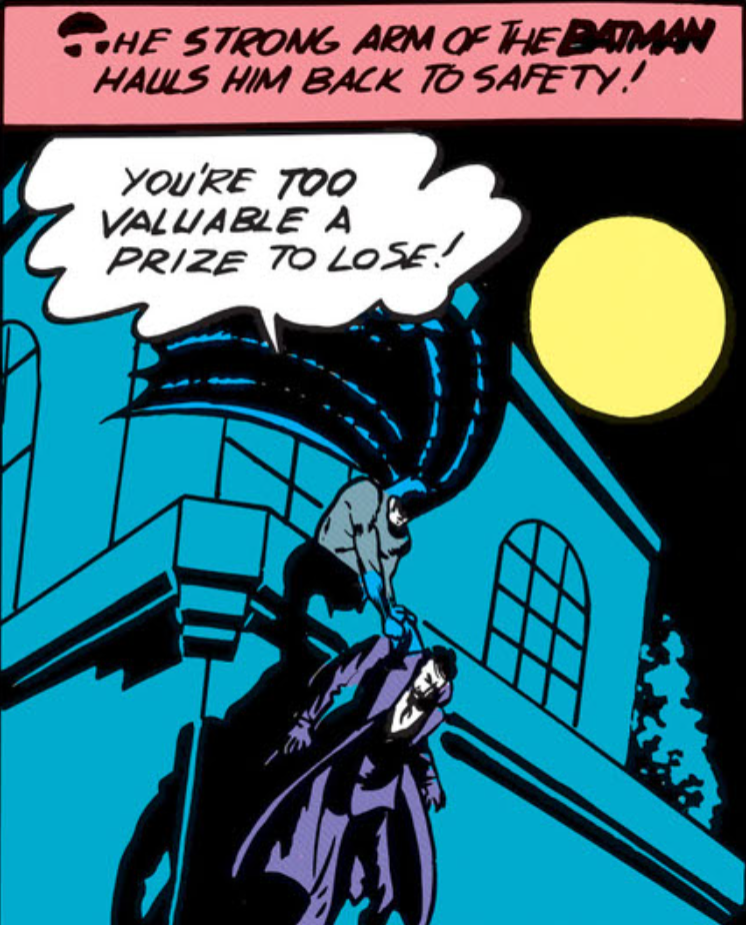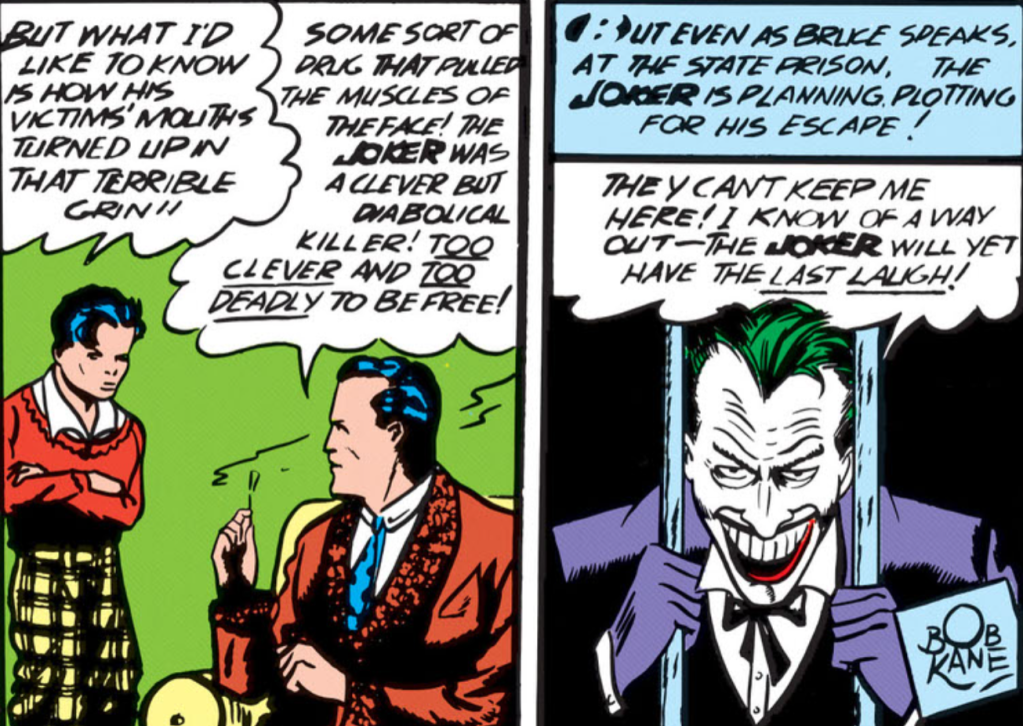“The Joker Returns”
The Joker is back! Already! According to the captions, it’s been literally TWO DAYS. I am choosing to believe that in the intervening time Batman has both slain the poor monster men AND gotten horny for Catwoman. He’s a Busy Guy.
It is essentially a reprise of the first story. We start with The Joker PO’d to heck because he feels like his Big Juicy Intellect has been insulted by being enjailed. You will recall how Batman had explosive chemicals in his boots. As I promised, The Joker also has explosive chemicals secreted about his person. But he keeps them deep in his craw, in fake molars.
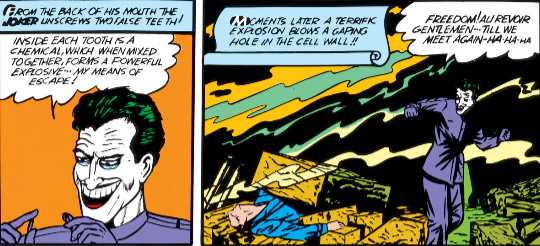
“He’s a very unusual man,” says Bruce, holding his chin in contemplation, “he will return with a vengeance!” The Joker’s hideout in this one is also pretty neat.
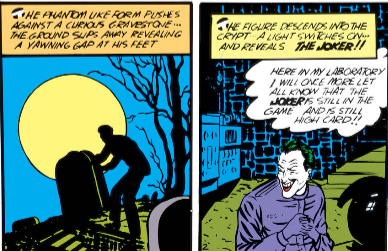
False teeth? Yes. False tombstone leading to a secret cemetery laboratory? Yes! Now that’s funereal!
He immediately starts doing the same exact thing he did last time, broadcasting a “message of doom” prophesying the certain death of somebody – this time the police chief himself. How is he getting radio equipment? How does Batman know what frequency to tune into? Quiet you.
We get more corpses “grinning in death” as they die of Joker venom. To kill the police chief he… plants a dart? in his phone? Then he calls him so the dart pokes him in the noggin? There’s a lot of potential points of failure here, but okay, sure! His plots are like little Rube-Goldberg machines.
Then he gets the ole Lust for Jewels and plans to steal “The Cleopatra Necklace” from a museum. Remember how he hid in a suit of armor in the first one? This time it’s a “mummy case.”
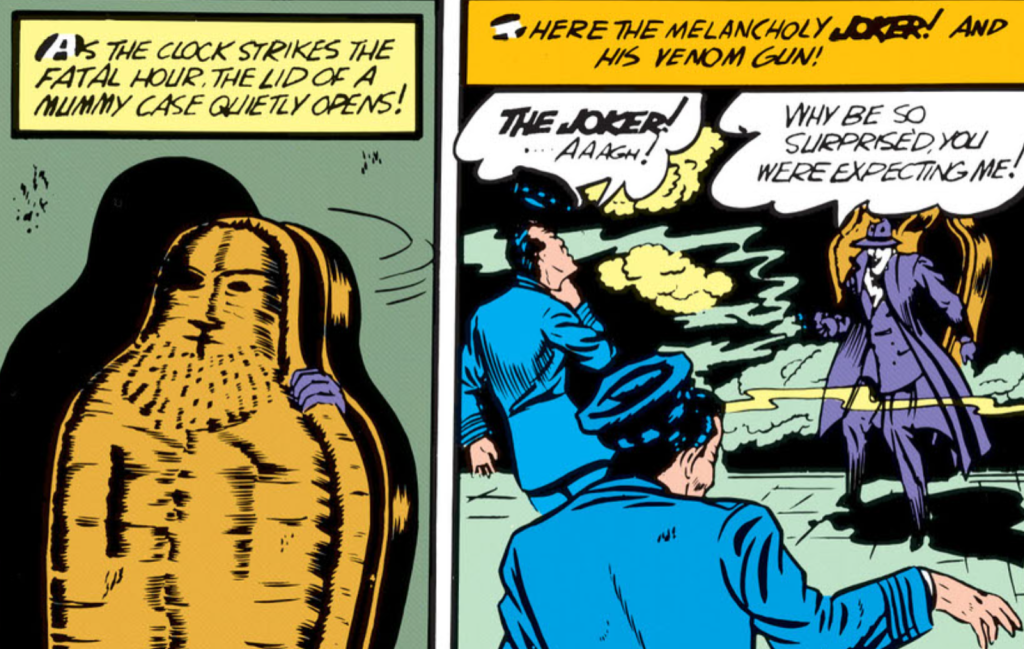
The captions continue to describe him as “melancholy” and “saturnine.” Which is neat, but I struggle to read that affect in his behavior and dialogue. He seems more… angry and petty. More temper tantrums than eerie sadness. Also, this is a phenomenal face. This is Squall-face.

Gonna be a prissy little pedant here, but that is not a mace, Joker. Anyway, he ruthlessly tries to chop Batman into pieces. There is a brutality to The Joker, I guess is what I meant before. Melancholy seems to imply stillness, weariness, even resignation. But The Joker just straight up has a lust for death. Only a couple pages in and he’s already killed four people. I get why he made such an impact from his first appearances. It’s not that he’s not cartoonish, but compared to so many of the other rogues we’ve seen so far, he is by far the most directly vicious and sadistic.
Anyway, the encounter leaves Batman dazed on the floor with the just-arrived police about to un-cowl him! The book pauses for a moment to drop a cliffhanger: “Is this the end of the mighty Batman?”
No, once again, of course not. He leaps miraculously to his feet and punches out the cops. Batman is “not quite ready for jail.”
Also, I am now imagining all of Batman’s “Sorry gentlemen”s in a suave transatlantic accent. Reader, I must apologize for not pointing out earlier how often Batman says things like, “Au revoir, gentlemen!” This was important and I was negligent in my duties. This is my canon now, but it is also delightful to imagine him saying all of these things in Bale-voice.
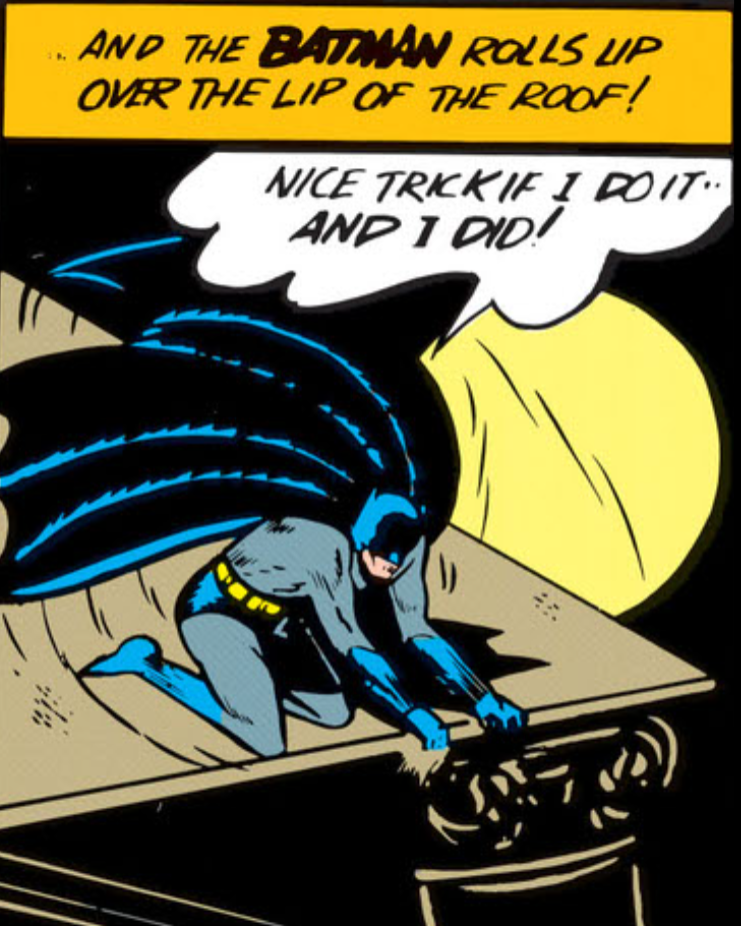
And I did! Love when Batman talks to himself. More of that “If you want to get me… you gotta get me first!” energy.

The Batman! Wattaman! Amazing, incredible. Also look at Batman’s 😮 face.
The book then introduces a “reformer” named Edgar Martin who is fed up with the police sucking at their jobs. But the Joker is like:
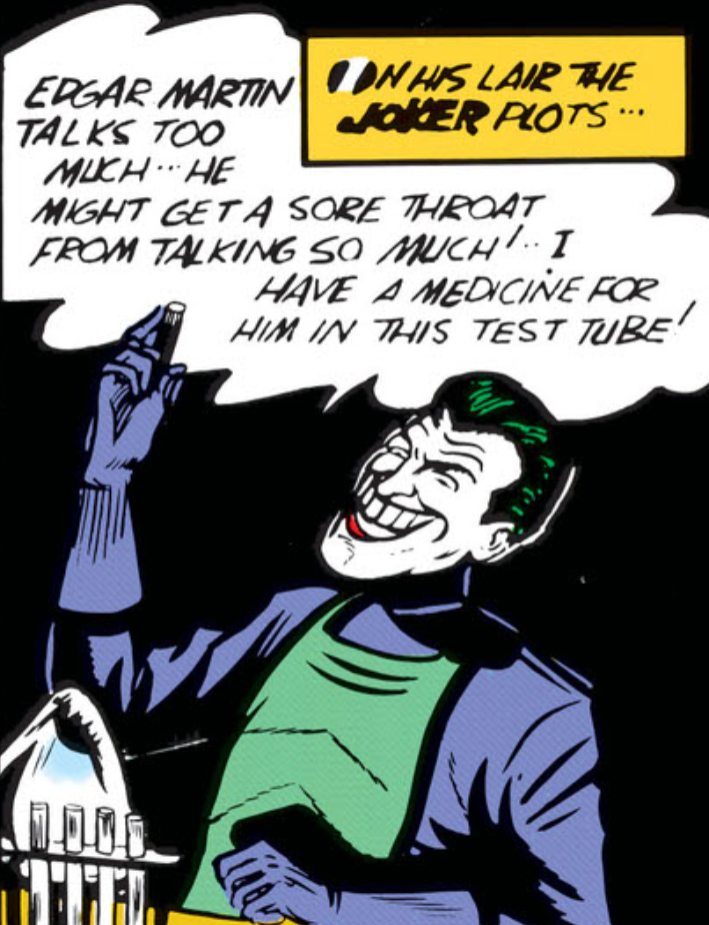
He then does his whole you’re going to die at the strike of 10 or whatever thing. This time he somehow has smuggled a pack of cards that is oops, all jokers covered in poison into Martin’s house. The cops in these issues are dumb as hell.
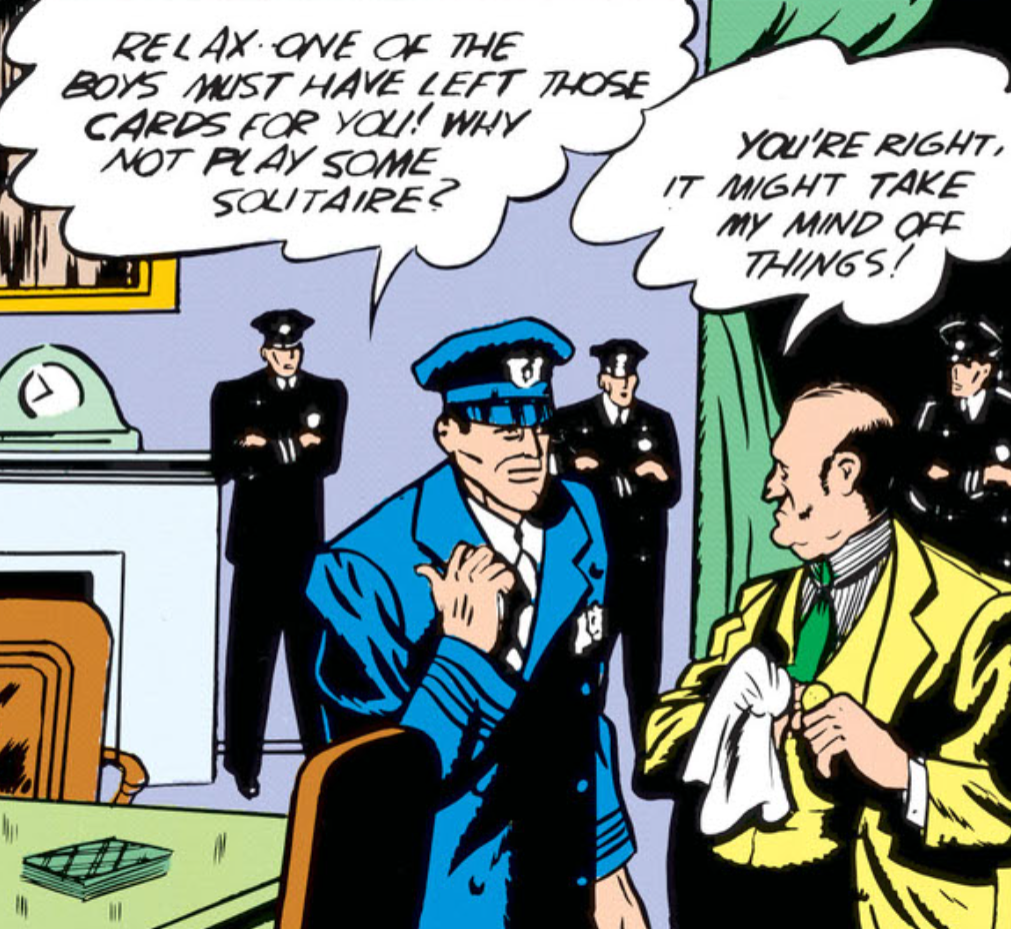
I will not believe that Finger is not straight dunking on them. Nothing suspicious about those cards that nobody knows where they came from. Shouldn’t they expect this by now? Last time they let a guy take a phone call and HE WAS KILLED BY THE PHONE. This is absolute negligence. This whole plot is unhinged. The Joker is leaving A LOT to chance. He is skating by on pure luck.

Those cards had venom on ’em. Batman needs faces like this again. Where else will you see this kind of artistic glory? I ask you. Speaking of museum-worthy faces, Bruce is back smoking pipes with Gordon, talking about crimes like it’s any of his business.
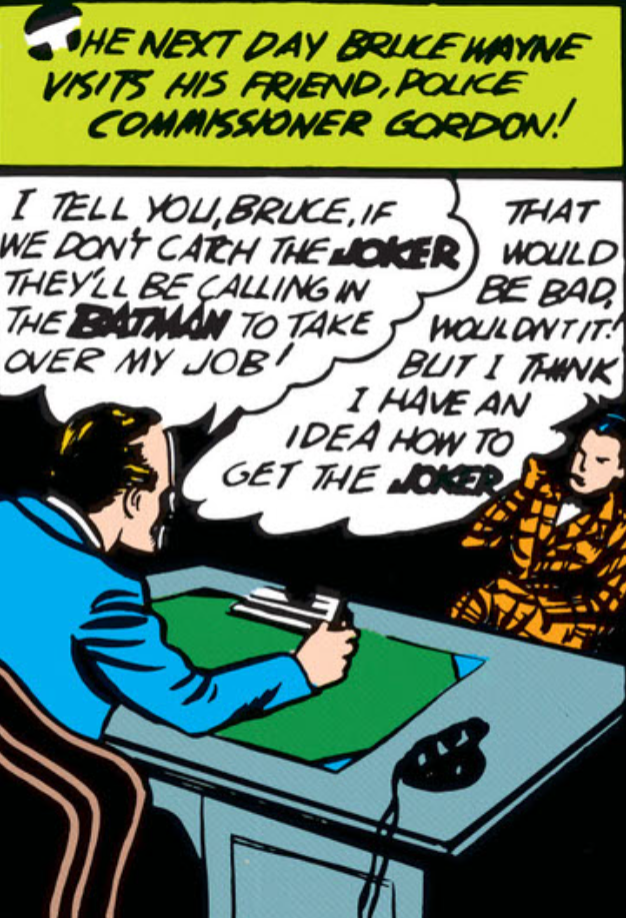
Look how smug he is thinking about being better at police than Gordon.

In case it was not crystal clear by now, villains in the 30s/40s were absolutely out of their mind horny for gems. Most importantly:

Truly we do not deserve these glories we have been gifted to behold.
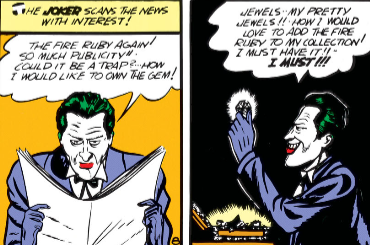
See, what did I JUST say. I MUST!!!
Also it is important to note that among the great pleasures of early Batman are things like: Batman driving his little car or Batman flying his little plane. But also The Joker reading the newspaper. They don’t make ’em like they used to. Everyone is learning about jewels to steal from the paper. As far as these comics would indicate, the paper is printing nothing but articles about which cool gems rich people have.
Yadda yadda he does the radio thing again. He runs into the police and starts “blazing away.”

He has killed at least eight people so far in this story alone. Anyway, he runs out onto the roof where he encounters the waiting Robin. The Joker punches him off the roof. (By my measure, the most dangerous hazards in the Batman universe are being punched off of buildings or getting blackjacked.) He catches himself on a flagpole and as Joker takes aim at Robin, about to kill him again, Batman steps out of an alley drawing his fire. This thankfully lets Robin plummet onto an extremely convenient awning allowing him to bounce and land on The Joker’s back.
I’m gonna put this next whole page because it’s quip city.
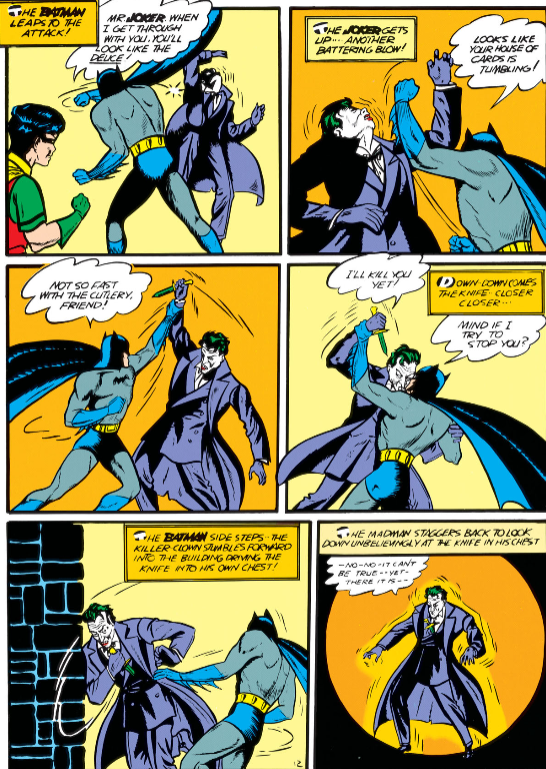
What does it mean to “look like a duece?” You’re the crappiest card in the deck? I guess when a guy makes playing cards his like whole thing this is a pretty bad burn.
“Mind if I try to stop you?” What can I say, dear reader. I merely bask in my delight. Could Cary Grant have played Batman? Can you imagine it? Well, stop, things are getting serious.
Then The Joker stabs himself and we get this wild panel:

THE LAUGH IS ON THE JOKER! LAUGH, CLOWN, LAUGH!!! The tone veers off a cliff here into something pretty damn disturbing. Also, if this looks familiar, you are right!
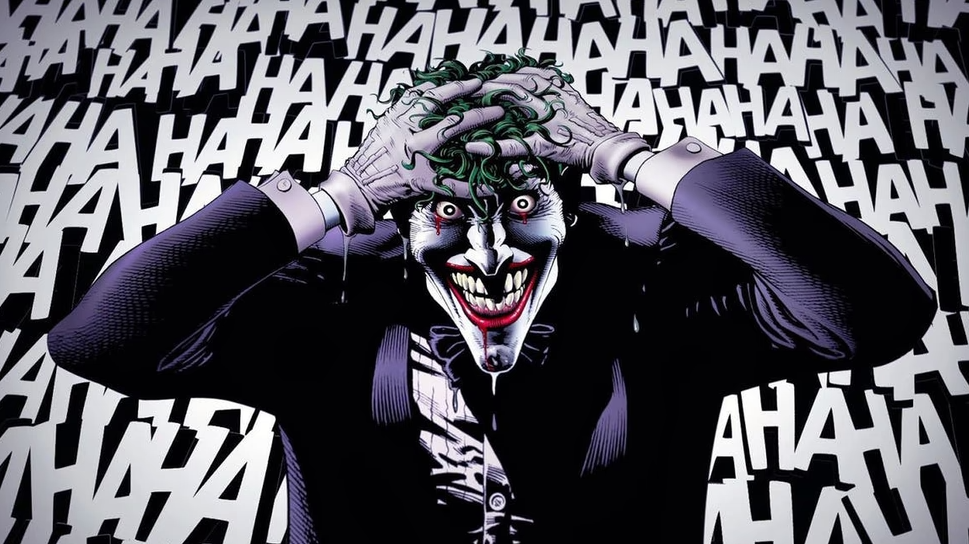
I didn’t know at the time that this was a callback to this issue!
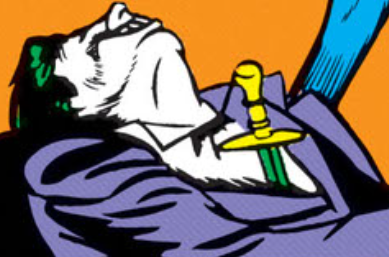
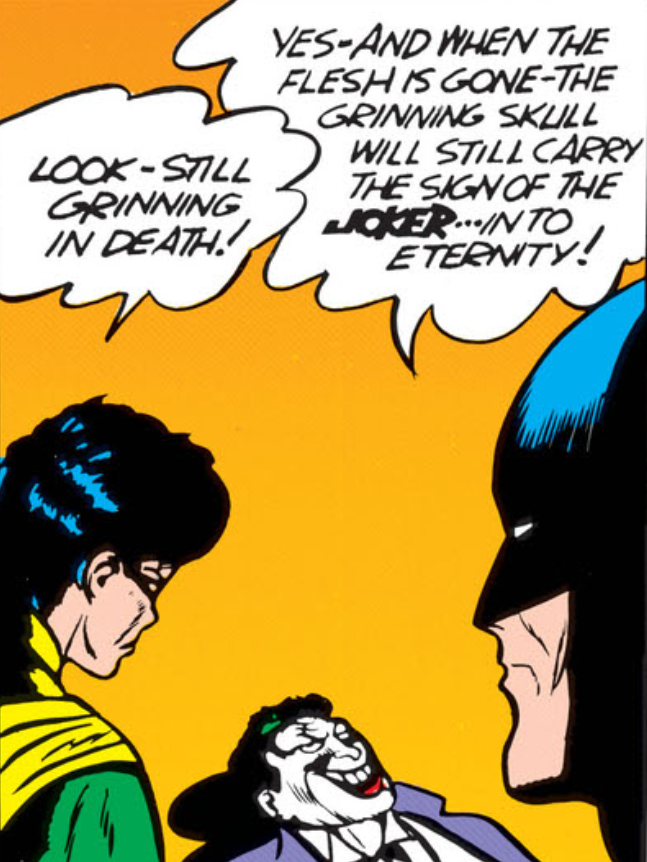
These faces are nuts. Also, Batman, what the HELL.
The duo leave his corpse for the police, but, of course, he is not, in fact, dead. He’s mysteriously still alive.
After re-reading this story, I’m actually pretty haunted by it. The Joker’s “death” is pretty terrifying. And his final lying there dead but alive ends the issue on an extremely bizarre supernatural note. It gives The Joker an inhuman cast, almost as if he can’t die. This seems to presage the many times Batman is unable to kill The Joker, from Killing Joke to The Dark Knight Returns to Legends of the Dark Knight. It’s, here, disconnected from his moral code, but the mysterious symbiosis of The Batman and The Joker is already present, as if they are reflections of one another, each unable to kill the other because they could not exist without their reflection.
That’s the overriding sense of this story to me: Batman’s dark mirror and the implication that inversions of him are almost leaping fully formed, from nowhere, into Gotham. It’s The Joker’s sheer brutality that I’m left with. The character fascinates because he is so strange and conflicting – the comic’s most superficially comedic and cartoonish entity is at once its most nihilistic and bloodthirsty. It seems fitting that we don’t know where The Joker came from. He is an emissary of the void.
Weirdly, I can’t say I love these initial stories. Despite what I just said, The Joker’s seething narcissistic pettiness feels repellant. The issue starts with him fuming about having his intellect slighted, for example. But maybe that’s part of the point. It is interesting that The Joker’s death is enabled by Batman willingly throwing himself into potential death (by gunfire) to save Robin. It’s almost as if Batman’s sudden flash of selflessness is what “kills” The Joker.
We’ve entered a whole ‘nother level in this story, I think. The latent psycho-mythology of Gotham is starting to congeal into something tangible. Of course, as a whole, Batman #1 is an absolutely wild tonal mishmash. But the pieces are clicking into place: purple pulp mixes with cartoonish comedy mixing, in turn, with startling violence and the first hints of that semi-oneiric psycho-myth. Monster Men was a dark issue, but, in a way, meta-textually – its darkness lying more in my response to Batman’s violation of the moral code I expected him to follow (based on my familiarity primarily with his future incarnations). This is probably Batman at its most overtly, textually dark, so far. It’s an issue saturated with grinning corpses and meaningless deaths in an almost existential darkness. I’m eager to see what lies ahead.
Oh and right, I almost forgot the very last panel: The, uh, “Golden Rules for ‘Robin’s Regulars’. Which seems to be like… be nice and helpful! But there’s no uniform or actual organization to join. Just be a good little doobie. Above all, follow the guidelines of this cute little acrostic:
Readiness
Obedience
Brotherhood
Industriousness
…
NATIONALISM?

WHAT!
Also, what does it MEAN to “be REGULAR!”
Good digestion? Just… be normal?
Also, why is Robin SCOWLING in the background? Isn’t this his thing?
I almost spit out my drink at NATIONALISM.
I’m at a loss for words, once again. You heard it here first, kids – nationalism is good!

